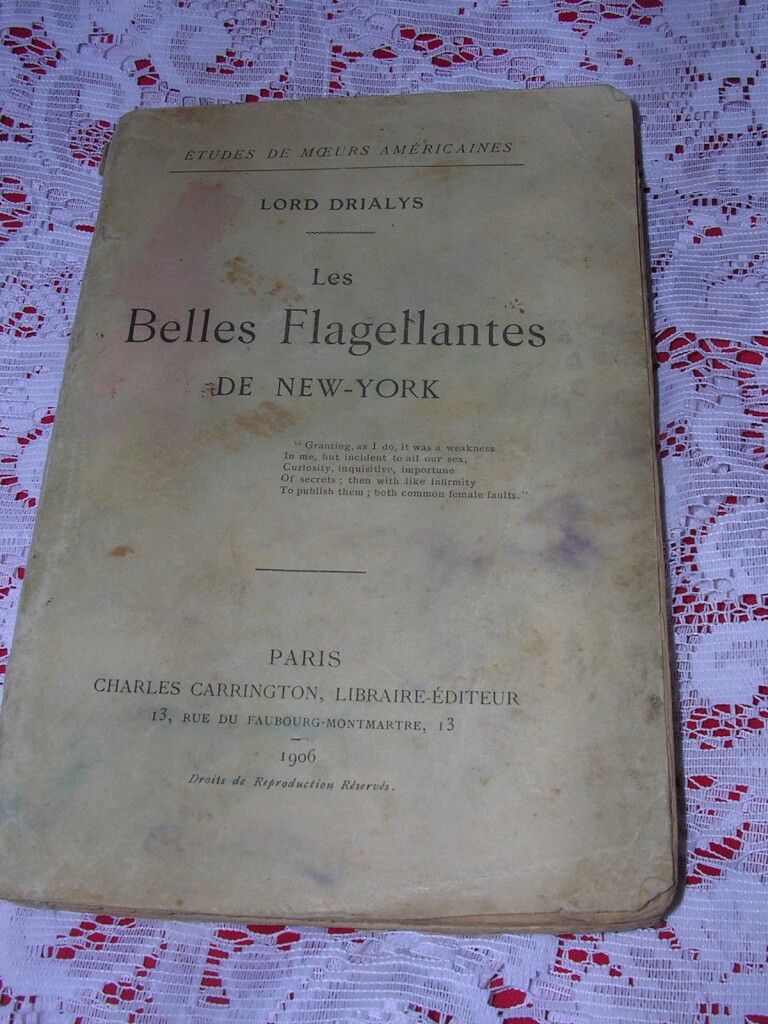-
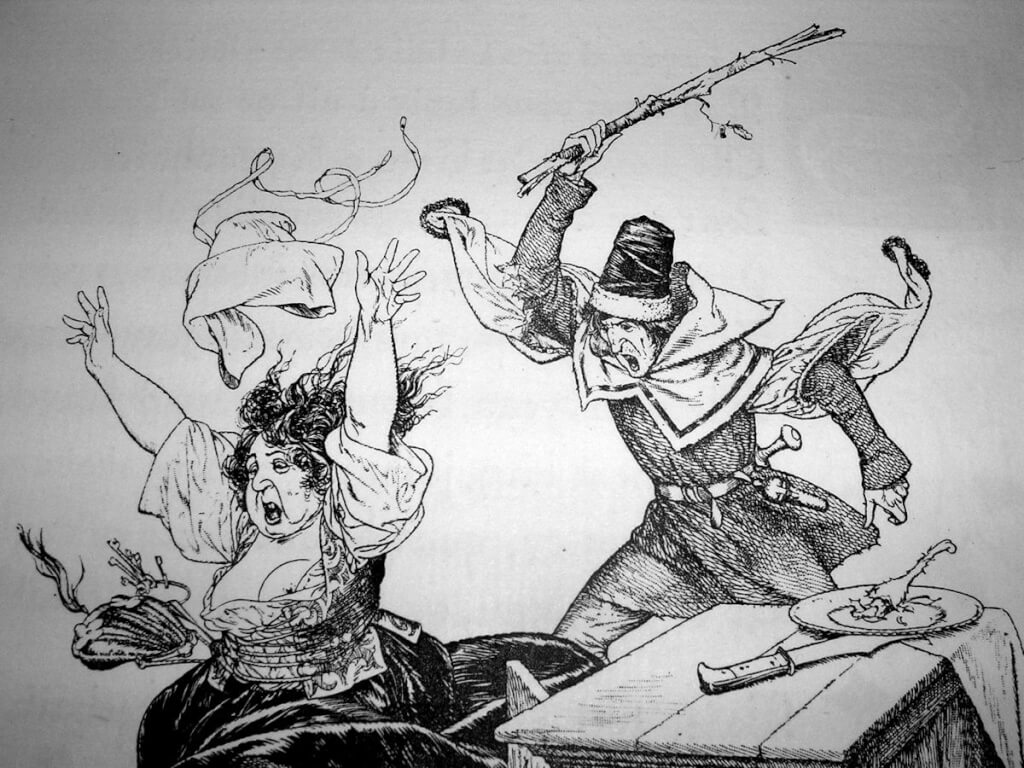
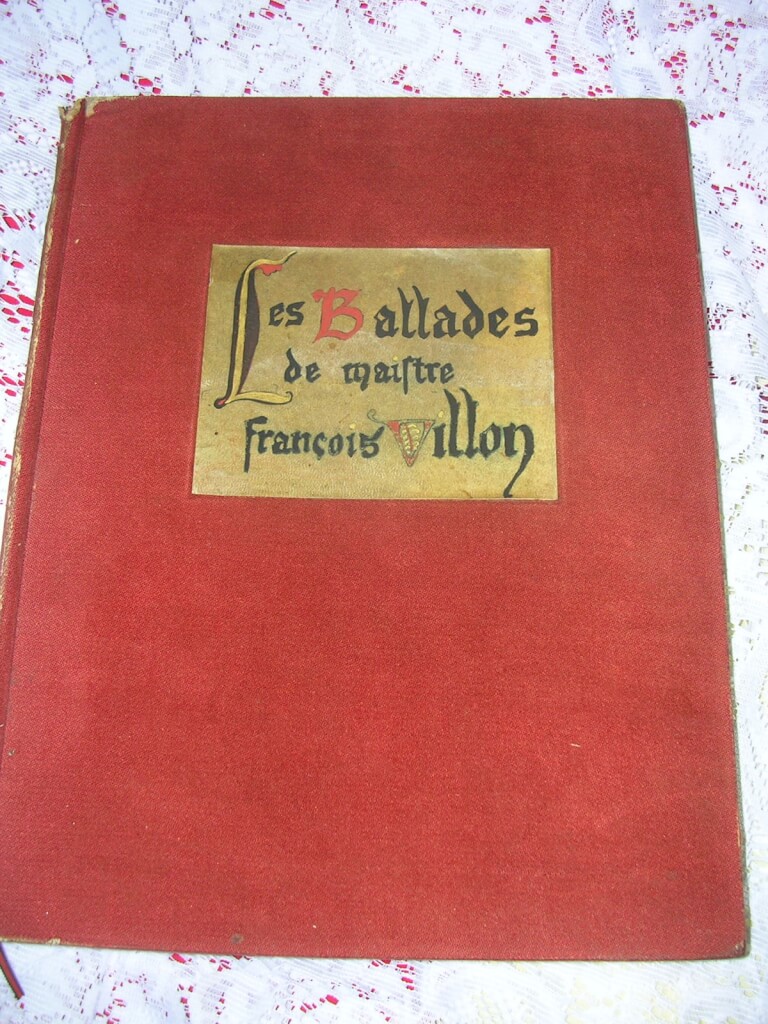 Les Ballades de Maistre Francois Villon, Francois Villon, illus. Chéri Hérouard, caligraphy ["escrites"] by Raymond de Rigné (chez Cres., Paris, 1919) 11.75" X 9.25", 169pp, rebound in red cloth boards with paper labels, decorated end papers. Original soft wraps intact. #450/550 signed by Hérouard. 31 full page drawings by Hérouard plus 31 small vignette type illustrations with a few "signed" by him. Beautifully printed on heavy deckle edged paper. good condition, wear to top and bottom of spine. ribbon intact. François Villon (c. 1431_1464) was a French poet. Most of what is known about Villon has been gathered from legal records and gleaned from his own writings. He was a thief, killer, barroom brawler, and vagabond. He is perhaps best known for his Testaments and his Ballades. He was the most famous realist poet of the Middle Ages. Chéri Hérouard (1881 - 1961) was a French illustrator who was most famously known for his forty-five-year work for French society magazine, La Vie Parisienne. Under the pseudonym of Herric, he also created erotic and sadomasochistic illustrations for various books including the Kama Sutra. This work was originally published with soft wraps. This copy has been beautifully rebound with it's original wraps intact.
Les Ballades de Maistre Francois Villon, Francois Villon, illus. Chéri Hérouard, caligraphy ["escrites"] by Raymond de Rigné (chez Cres., Paris, 1919) 11.75" X 9.25", 169pp, rebound in red cloth boards with paper labels, decorated end papers. Original soft wraps intact. #450/550 signed by Hérouard. 31 full page drawings by Hérouard plus 31 small vignette type illustrations with a few "signed" by him. Beautifully printed on heavy deckle edged paper. good condition, wear to top and bottom of spine. ribbon intact. François Villon (c. 1431_1464) was a French poet. Most of what is known about Villon has been gathered from legal records and gleaned from his own writings. He was a thief, killer, barroom brawler, and vagabond. He is perhaps best known for his Testaments and his Ballades. He was the most famous realist poet of the Middle Ages. Chéri Hérouard (1881 - 1961) was a French illustrator who was most famously known for his forty-five-year work for French society magazine, La Vie Parisienne. Under the pseudonym of Herric, he also created erotic and sadomasochistic illustrations for various books including the Kama Sutra. This work was originally published with soft wraps. This copy has been beautifully rebound with it's original wraps intact. -
Out of stock
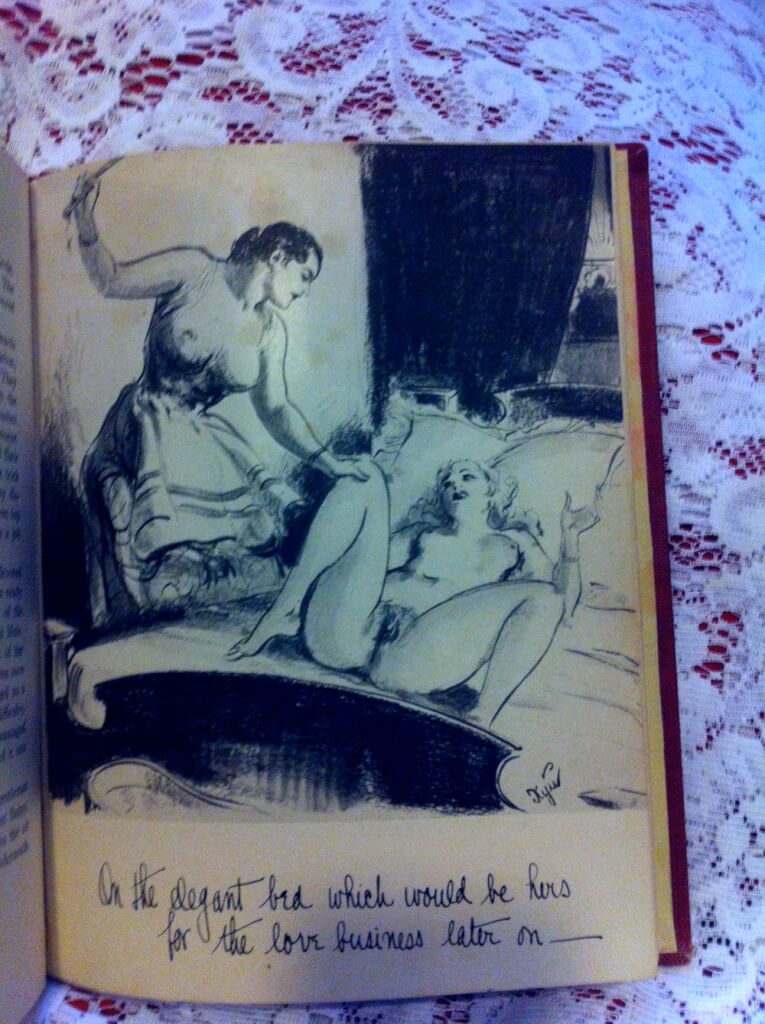
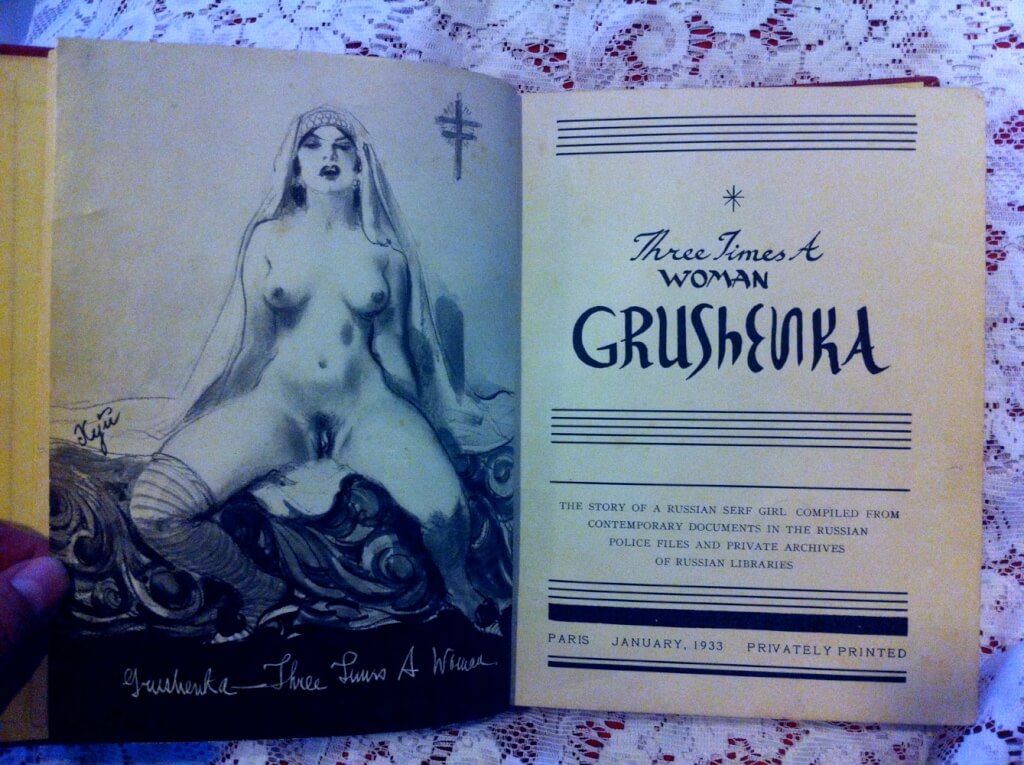 Three Times a Woman, Grushenka, anonymous [possibly Val Lewton?], illus. "a young Russian residing in Paris, who unfortunately must remain anonymous" (Privately Printed, London [New York], 1933) 9" X 7", 252pp, hardbound no DJ, red boards with gilt title on spine, good condition, minor wear and bumping, anonymous bookplate with the profile of a man made from many copulating couples. Title page reads: "The Story of a Russian Serf Girl Compiled from Contemporary Documents in the Russian Police Files and Private Archives of Russian Libraries" Originally published at New York in 1933 with a false Paris imprint. Val Lewton, the supposed author, was a well known film producer, responsible for a series of good low-budget horror movies in the 1940's by such directors as Robert Wise, Mark Robson and Jacques Tourneur. The book purports to be a flaggelation story written by a Russian living in Paris and then translated to english. The story takes place c. 1728, "shortly after the death of Peter the Great". The main character is Grushenka Pavlovsk. This edition is complete with very explicit illustrations.
Three Times a Woman, Grushenka, anonymous [possibly Val Lewton?], illus. "a young Russian residing in Paris, who unfortunately must remain anonymous" (Privately Printed, London [New York], 1933) 9" X 7", 252pp, hardbound no DJ, red boards with gilt title on spine, good condition, minor wear and bumping, anonymous bookplate with the profile of a man made from many copulating couples. Title page reads: "The Story of a Russian Serf Girl Compiled from Contemporary Documents in the Russian Police Files and Private Archives of Russian Libraries" Originally published at New York in 1933 with a false Paris imprint. Val Lewton, the supposed author, was a well known film producer, responsible for a series of good low-budget horror movies in the 1940's by such directors as Robert Wise, Mark Robson and Jacques Tourneur. The book purports to be a flaggelation story written by a Russian living in Paris and then translated to english. The story takes place c. 1728, "shortly after the death of Peter the Great". The main character is Grushenka Pavlovsk. This edition is complete with very explicit illustrations. -

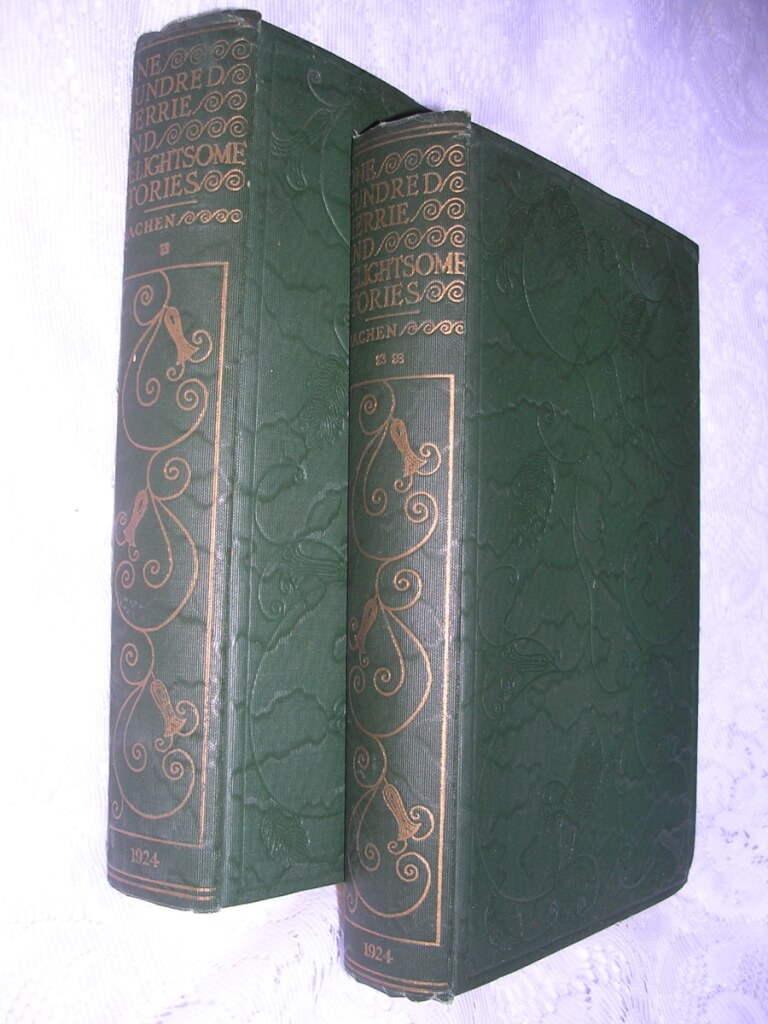 One Hundred Merrie and Delightsome Stories (Les Cent Nouvelles Nouvelles) (2 volumes), trans. Robert B. Douglas (Privately Printed for Subscribers only, Carbonnek, 1924, #591/1250) 8 7/8" X 5 3/4", 2 vol. 279pp 272pp, hardbound no DJ, dark green moire silk boards decorated in blind stamp, spines lettered and decorated in gilt, gilt top edge, other edges deckle, frontispiece signed by the artist, Clara Tice, very good condition, slight bumping on corners This is a two volume set of books beautifully bound and in excellent condition. Some pages remain uncut. A rare book in rare condition. It is signed by the artist, Clara Tice, under the frontispiece. It is illustrated with 16 full page drawings by Clara Tice. Purported a collection of short stories narrated by various persons at the court of Philippe le Bon, and collected together by Antoine de la Sale, the nouvelles are, according to the authority on French Literature—Professor George Saintsbury "undoubtedly the first work of literary prose in French ... The short prose tale of a comic character is the one French literary product the pre-eminence and perfection of which it is impossible to dispute, and the prose tale first appears to advantage in the Cent Nouvelles Nouvelles." The stories give a curious glimpses of life in the 15th century, providing a genuine view of the social condition of the nobility and the middle classes. M. Lenient, a French critic, says: "Generally the incidents and personages belong to the bourgeoisée; there is nothing chivalric, nothing wonderful; no dreamy lovers, romantic dames, fairies, or enchanters. Noble dames, bourgeois, nuns, knights, merchants, monks, and peasants mutually dupe each other. The lord deceives the miller's wife by imposing on her simplicity, and the miller retaliates in much the same manner. The shepherd marries the knight's sister, and the nobleman is not over scandalized. The vices of the monks are depicted in half a score tales, and the seducers are punished with a severity not always in proportion to the offence." For four centuries 10 of the stories were credited to Louis XI. Modern scholars have since ascribed them to either Philippe le Bel or Comte de Charolais. In all, some thirty-two noblemen or squires contributed the stories, with some 14 or 15 taken from Giovanni Boccaccio, and as many more from Gian Francesco Poggio Bracciolini or other Italian writers, or French fabliaux, but about 70 of them appear to be original.
One Hundred Merrie and Delightsome Stories (Les Cent Nouvelles Nouvelles) (2 volumes), trans. Robert B. Douglas (Privately Printed for Subscribers only, Carbonnek, 1924, #591/1250) 8 7/8" X 5 3/4", 2 vol. 279pp 272pp, hardbound no DJ, dark green moire silk boards decorated in blind stamp, spines lettered and decorated in gilt, gilt top edge, other edges deckle, frontispiece signed by the artist, Clara Tice, very good condition, slight bumping on corners This is a two volume set of books beautifully bound and in excellent condition. Some pages remain uncut. A rare book in rare condition. It is signed by the artist, Clara Tice, under the frontispiece. It is illustrated with 16 full page drawings by Clara Tice. Purported a collection of short stories narrated by various persons at the court of Philippe le Bon, and collected together by Antoine de la Sale, the nouvelles are, according to the authority on French Literature—Professor George Saintsbury "undoubtedly the first work of literary prose in French ... The short prose tale of a comic character is the one French literary product the pre-eminence and perfection of which it is impossible to dispute, and the prose tale first appears to advantage in the Cent Nouvelles Nouvelles." The stories give a curious glimpses of life in the 15th century, providing a genuine view of the social condition of the nobility and the middle classes. M. Lenient, a French critic, says: "Generally the incidents and personages belong to the bourgeoisée; there is nothing chivalric, nothing wonderful; no dreamy lovers, romantic dames, fairies, or enchanters. Noble dames, bourgeois, nuns, knights, merchants, monks, and peasants mutually dupe each other. The lord deceives the miller's wife by imposing on her simplicity, and the miller retaliates in much the same manner. The shepherd marries the knight's sister, and the nobleman is not over scandalized. The vices of the monks are depicted in half a score tales, and the seducers are punished with a severity not always in proportion to the offence." For four centuries 10 of the stories were credited to Louis XI. Modern scholars have since ascribed them to either Philippe le Bel or Comte de Charolais. In all, some thirty-two noblemen or squires contributed the stories, with some 14 or 15 taken from Giovanni Boccaccio, and as many more from Gian Francesco Poggio Bracciolini or other Italian writers, or French fabliaux, but about 70 of them appear to be original. -
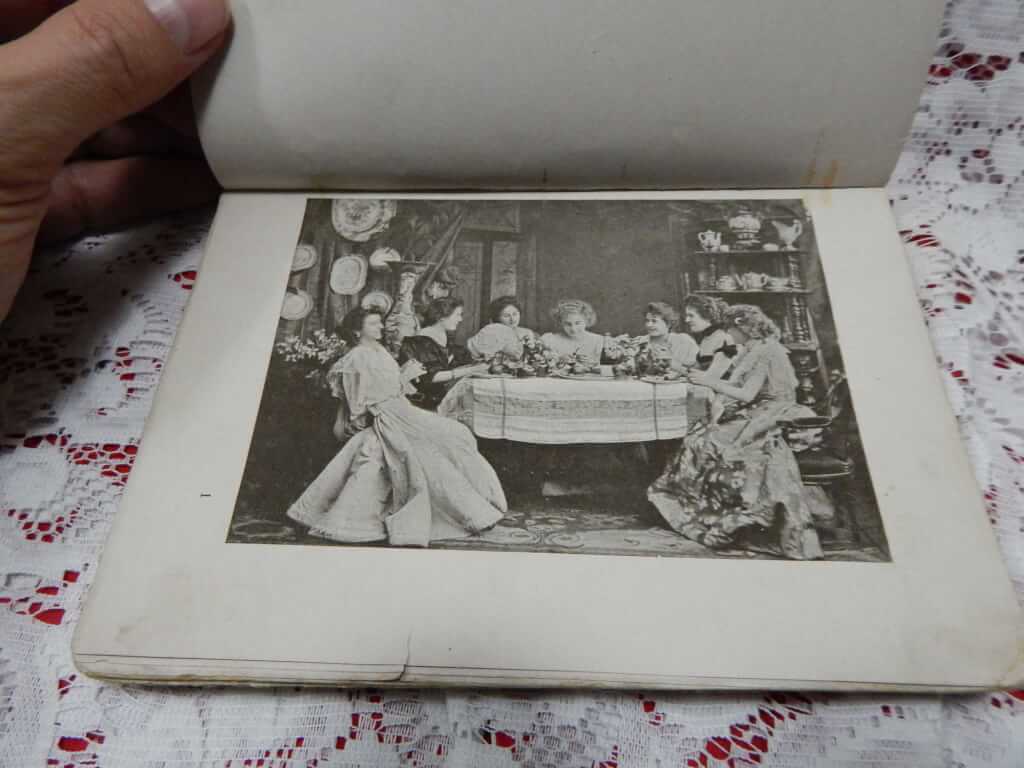
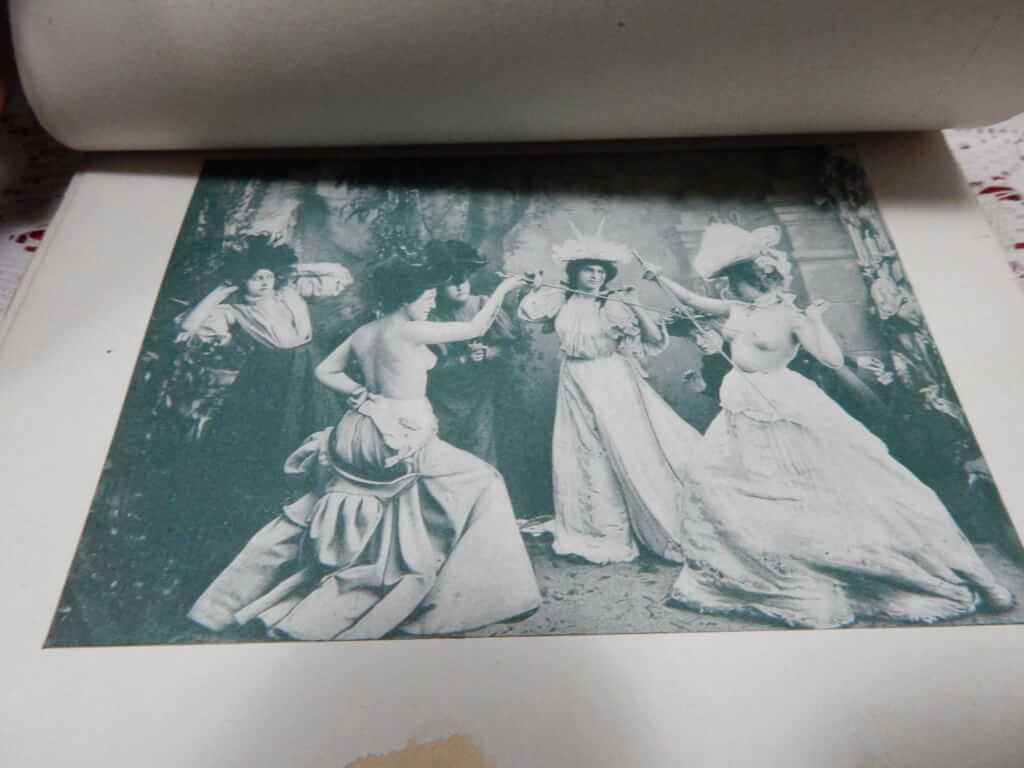 Photo Album (ca. 1900), 81 photos, 6 themed series: Le Duel (The Duel), La Deception (The Deception), Les Armurea (The Armor), La Soubrette (The Coy Soprano), Le Coucher (Going to Bed), Le Bain (The Bath), no date, no photographer, no publisher. 7.25" x 5.5", 87pp unpaginated, no boards, signatures with rivets (no longer holding) and taped together. 81 photos are grouped into 6 "photo stories". The only other marking is on the second photo and reads "SADAG, SW" The photos are elaborately staged photo. Each series starts out with the subject(s) fully clothed, but at some point becoming partially undressed. "SADAG" is "Société Anonyme des Arts Graphiques". According to books from England and France they were a "well known Geneva firm of photo engravers". The marking on the photo could mean that the the photos were processed by a member of this organization or it was processed using the techniques developed by this organization. Le Duel (14 photos) portrays a group of ladies at a lunch or tea. They start drinking and fight breaks out resulting in a duel. The duel is, of course, performed topless. In the end the winner consoles the loser. La Deception (15 photos) portrays a woman sitting in her parlor and her table is set for a two. She reads a letter/note which upsets her then angers her. She clears away the extra table setting and starts to drink wine. The more drunk she gets the less clothes she has on. In the last photo she is passed out and there are two cherubs flying around the room. In Les Armurea (11 photos) a woman is admiring two suits of armor. She undresses and puts on one of the suits of armor. La Soubrette (15 photos, roughly translated as "The Coy Soprano") a maid is cleaning up a woman's dressing room. She decides to play the soprano. She undresses, lets her hair down, uses the brush and puts on a fancy dress. Le Coucher (16 photos, "Going to Bed") is a photo story about a woman preparing for bed. Le Bain (10 photos, "The Bath") a woman prepares for and takes a bath.
Photo Album (ca. 1900), 81 photos, 6 themed series: Le Duel (The Duel), La Deception (The Deception), Les Armurea (The Armor), La Soubrette (The Coy Soprano), Le Coucher (Going to Bed), Le Bain (The Bath), no date, no photographer, no publisher. 7.25" x 5.5", 87pp unpaginated, no boards, signatures with rivets (no longer holding) and taped together. 81 photos are grouped into 6 "photo stories". The only other marking is on the second photo and reads "SADAG, SW" The photos are elaborately staged photo. Each series starts out with the subject(s) fully clothed, but at some point becoming partially undressed. "SADAG" is "Société Anonyme des Arts Graphiques". According to books from England and France they were a "well known Geneva firm of photo engravers". The marking on the photo could mean that the the photos were processed by a member of this organization or it was processed using the techniques developed by this organization. Le Duel (14 photos) portrays a group of ladies at a lunch or tea. They start drinking and fight breaks out resulting in a duel. The duel is, of course, performed topless. In the end the winner consoles the loser. La Deception (15 photos) portrays a woman sitting in her parlor and her table is set for a two. She reads a letter/note which upsets her then angers her. She clears away the extra table setting and starts to drink wine. The more drunk she gets the less clothes she has on. In the last photo she is passed out and there are two cherubs flying around the room. In Les Armurea (11 photos) a woman is admiring two suits of armor. She undresses and puts on one of the suits of armor. La Soubrette (15 photos, roughly translated as "The Coy Soprano") a maid is cleaning up a woman's dressing room. She decides to play the soprano. She undresses, lets her hair down, uses the brush and puts on a fancy dress. Le Coucher (16 photos, "Going to Bed") is a photo story about a woman preparing for bed. Le Bain (10 photos, "The Bath") a woman prepares for and takes a bath. -
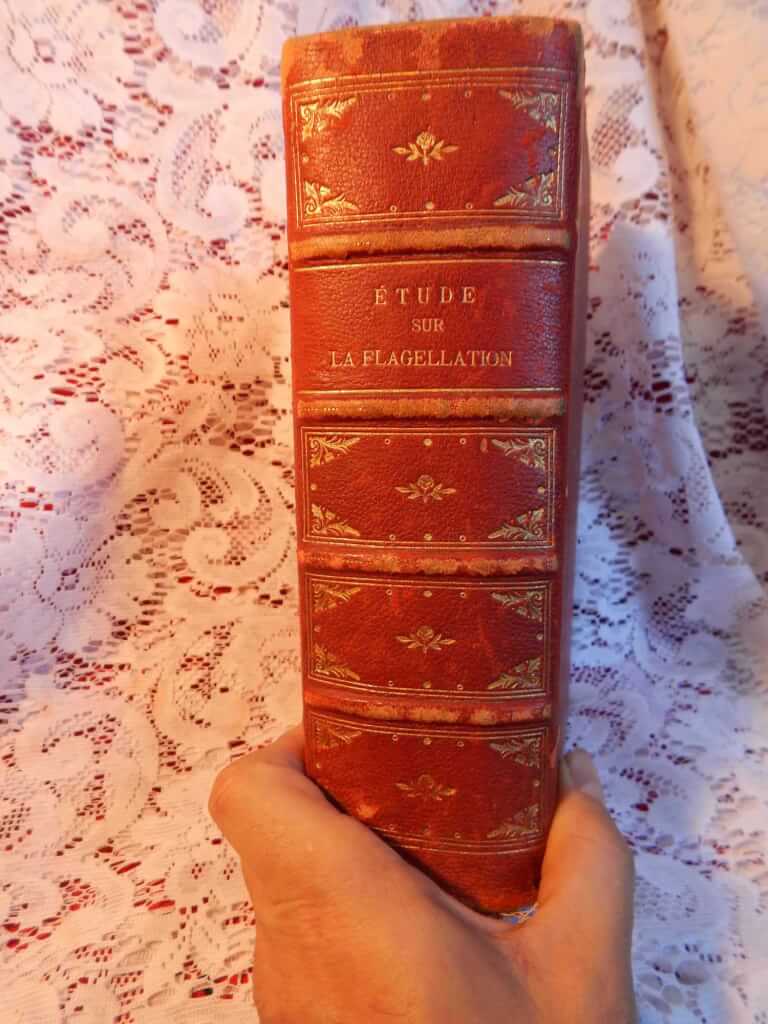
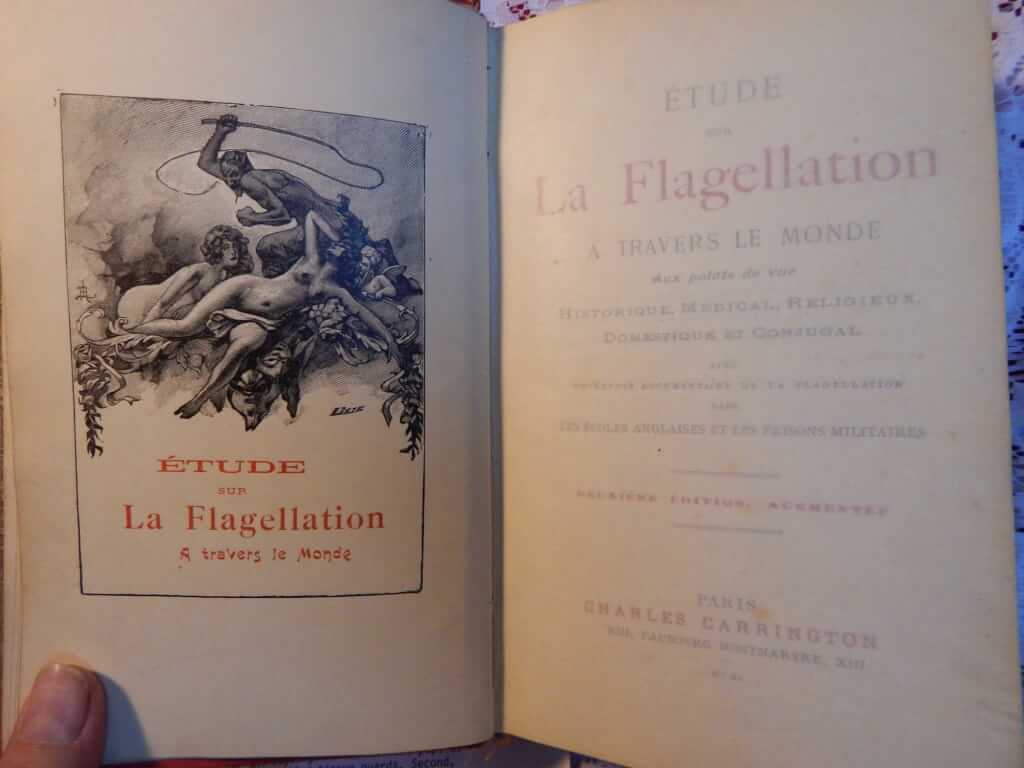 Étude sur La Flagellation a travers le monde aux points de vue Historique, Medical, Religieux, Domestique et Conjugal | avec un exposé documentaire de la flagellation dans Les écoles anglaises et les prisons militaires, Deuxiéme Édition, Augmentée [Study of the Flagellation throughout the world from the historical, medical, religious, domestic and marital points of view | with a documentary presentation of flogging in English Schools and Military Prisons, Second Edition, Augmented], by Jean de Villiot [pseud. most likely of Charles Carrington, Hugues Rebell and Hector France],illust. by René Lelong, (Charles Carrington, Paris, 1901, "Second Edition Augmented", printed by Achevé d'imprimer le 29 septembre 1900 par Em. Pivoteau. Imprimeur à Saint-Amand-Mont-Rond (Cher)) 5.5"x8.5", xxiv+646pp, quarter-bound in red morocco over red boards, 4 raised bands, gilt titles and decorations on spine, marbled paste-downs, all edges gilt, ribbon intact, binding frayed a bit at bottom, some rubbing and stains, otherwise very good condition for age, frontispiece and 20 B&W illustrations by René Lelong tipped in with titled tissue guards. This book is the compilation and expansion of a few other books previously published by Charles Carrington including the original Étude sur La Flagellation a travers le monde published in 1898. It represents a more complete representation of those writings beautifully bound into one book, covering studies on flogging through the centuries, flogging in England, flogging in the history of France (the cases of Madame Du Barry, the Marquise de Rosen.), the flogging from the medical point of view where one learns its healing properties, flogging in literature or the art of using it for pleasure, the discipline to school and domestic and spousal corrections, and "in our current society". Jean de Villiot is a pseudonym frequently used by Carrington and the various authors he relied upon, especially for works that involved flagellation. The illustrator, René Lelong was a third class medalist at the Salon des artistes français of 1895 which he became a member from 1898. He has produced advertising posters and illustrated numerous books and texts. He was a professor at the Julian Academy from 1879 to 1891.
Étude sur La Flagellation a travers le monde aux points de vue Historique, Medical, Religieux, Domestique et Conjugal | avec un exposé documentaire de la flagellation dans Les écoles anglaises et les prisons militaires, Deuxiéme Édition, Augmentée [Study of the Flagellation throughout the world from the historical, medical, religious, domestic and marital points of view | with a documentary presentation of flogging in English Schools and Military Prisons, Second Edition, Augmented], by Jean de Villiot [pseud. most likely of Charles Carrington, Hugues Rebell and Hector France],illust. by René Lelong, (Charles Carrington, Paris, 1901, "Second Edition Augmented", printed by Achevé d'imprimer le 29 septembre 1900 par Em. Pivoteau. Imprimeur à Saint-Amand-Mont-Rond (Cher)) 5.5"x8.5", xxiv+646pp, quarter-bound in red morocco over red boards, 4 raised bands, gilt titles and decorations on spine, marbled paste-downs, all edges gilt, ribbon intact, binding frayed a bit at bottom, some rubbing and stains, otherwise very good condition for age, frontispiece and 20 B&W illustrations by René Lelong tipped in with titled tissue guards. This book is the compilation and expansion of a few other books previously published by Charles Carrington including the original Étude sur La Flagellation a travers le monde published in 1898. It represents a more complete representation of those writings beautifully bound into one book, covering studies on flogging through the centuries, flogging in England, flogging in the history of France (the cases of Madame Du Barry, the Marquise de Rosen.), the flogging from the medical point of view where one learns its healing properties, flogging in literature or the art of using it for pleasure, the discipline to school and domestic and spousal corrections, and "in our current society". Jean de Villiot is a pseudonym frequently used by Carrington and the various authors he relied upon, especially for works that involved flagellation. The illustrator, René Lelong was a third class medalist at the Salon des artistes français of 1895 which he became a member from 1898. He has produced advertising posters and illustrated numerous books and texts. He was a professor at the Julian Academy from 1879 to 1891. -
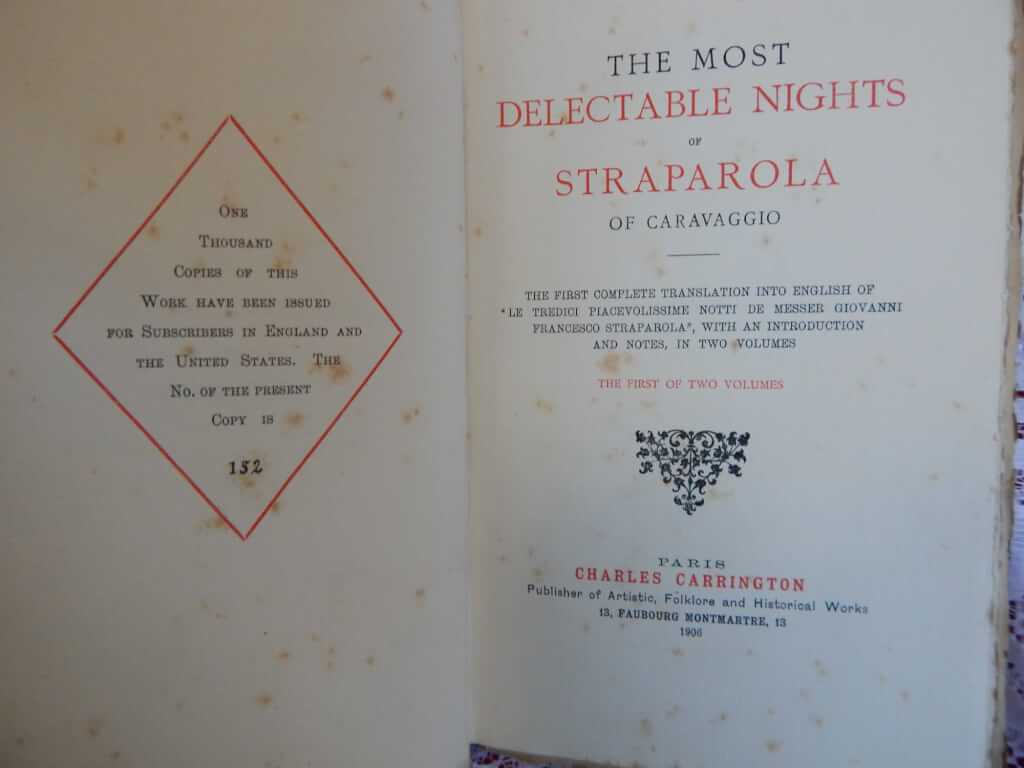
 The Most Delectable Nights of Straparola of Caravaggio, the first complete translation into english of "Le tredici piacevolissime notte, de Mesier Giovanni Francesco Straparola", with an introduction and notes, in two volumes, illust. by Léon Lebègue and Adolph Lambrecht (Charles Carrington, "Publisher of Artistic, Folklore and Historical Works", Paris, 1906, #152/1000, [first english translation, first edition] "Printed in Holland at the Printing Works of G. J. Thieme, Nymeguen.") 5.75"x8.5", 2 vol. xvi+352pp, xl+420pp, top edge gilt other edges deckled, blue boards with gilt borders and gilt lettering to the spines, red and black text and decorations throughout, numerous illustrations, both vignettes within text and tipped-in full color plates with descriptive tissue guards, handsome good+ copy for age, some foxing, small tear at top of vol. 1 spine, slight sunning to boards. This is a rare, beautifully executed, 1st edition, 1st English translation, 1st printing, low number limited edition, by Charles Carrington. Giovanni Francesco "Gianfrancesco" Straparola, also known as Zoan or Zuan Francesco Straparola da Caravaggio (1485?-1558) was a writer of poetry, and collector and writer of short stories. Some time during his life, he migrated from Caravaggio to Venice where he published a collection of stories in two volumes called Le piacevoli notti (1551 and 1553) (The Pleasant Nights, first translated by W. G. Waters in 1901 as "The Facetious Nights"). The Pleasant Nights is the work for which Straparola is most noted, and which contains a total of seventy-five short stories, fables, and fairy tales. The tales, or novelle, are divided into Nights, rather than chapters, and resemble the type of narrative presentation found in Boccaccio's Decameron. This presentation is of a gathering of Italian aristocrats, men and women, who entertain themselves by singing songs, dancing, telling stories and presenting enigmas (riddles). The Pleasant Nights contains many different types of tales, including realistic novellas, stories about practical jokes, tragic and triumphant love stories, bawdy tales, and animal stories. Some sixteen of these 74 tales are fairy tales including the story of Puss-in-Boots, the story of an impoverished boy whose enchanted cat earns him wealth, marriage to a princess, and a kingdom. Among the other fairy tales in The Pleasant Nights, we find a dragon slayer tale; the tale of a prince born in the shape of a pig due to a fairy’s curse who regains his human form only after marrying three time,; the story of Biancabella or “White Beauty” a princes who undergoes many trials until finally being saved by a fairy; and the a poor girl who acquire a magic doll that poops money and helps her marry a prince. It is claimed that many of the stories within The Pleasant Nights had been taken from earlier works, specifically from Girolamo Morlini, a 15th/16th century lawyer from Naples. If taken at his word, Straparola never denied this. In the Dedication at the front of the second volume, Straparola wrote that the stories ". . . written and collected in this volume [vol. 2 only?] are none of mine, but goods which I have feloniously taken from this man and that. Of a truth I confess they are not mine, and if I said otherwise I should lie, but nevertheless I have faithfully set them down according to the manner in which they were told by the ladies, nobles, learned men and gentlemen who gathered together for recreation."
The Most Delectable Nights of Straparola of Caravaggio, the first complete translation into english of "Le tredici piacevolissime notte, de Mesier Giovanni Francesco Straparola", with an introduction and notes, in two volumes, illust. by Léon Lebègue and Adolph Lambrecht (Charles Carrington, "Publisher of Artistic, Folklore and Historical Works", Paris, 1906, #152/1000, [first english translation, first edition] "Printed in Holland at the Printing Works of G. J. Thieme, Nymeguen.") 5.75"x8.5", 2 vol. xvi+352pp, xl+420pp, top edge gilt other edges deckled, blue boards with gilt borders and gilt lettering to the spines, red and black text and decorations throughout, numerous illustrations, both vignettes within text and tipped-in full color plates with descriptive tissue guards, handsome good+ copy for age, some foxing, small tear at top of vol. 1 spine, slight sunning to boards. This is a rare, beautifully executed, 1st edition, 1st English translation, 1st printing, low number limited edition, by Charles Carrington. Giovanni Francesco "Gianfrancesco" Straparola, also known as Zoan or Zuan Francesco Straparola da Caravaggio (1485?-1558) was a writer of poetry, and collector and writer of short stories. Some time during his life, he migrated from Caravaggio to Venice where he published a collection of stories in two volumes called Le piacevoli notti (1551 and 1553) (The Pleasant Nights, first translated by W. G. Waters in 1901 as "The Facetious Nights"). The Pleasant Nights is the work for which Straparola is most noted, and which contains a total of seventy-five short stories, fables, and fairy tales. The tales, or novelle, are divided into Nights, rather than chapters, and resemble the type of narrative presentation found in Boccaccio's Decameron. This presentation is of a gathering of Italian aristocrats, men and women, who entertain themselves by singing songs, dancing, telling stories and presenting enigmas (riddles). The Pleasant Nights contains many different types of tales, including realistic novellas, stories about practical jokes, tragic and triumphant love stories, bawdy tales, and animal stories. Some sixteen of these 74 tales are fairy tales including the story of Puss-in-Boots, the story of an impoverished boy whose enchanted cat earns him wealth, marriage to a princess, and a kingdom. Among the other fairy tales in The Pleasant Nights, we find a dragon slayer tale; the tale of a prince born in the shape of a pig due to a fairy’s curse who regains his human form only after marrying three time,; the story of Biancabella or “White Beauty” a princes who undergoes many trials until finally being saved by a fairy; and the a poor girl who acquire a magic doll that poops money and helps her marry a prince. It is claimed that many of the stories within The Pleasant Nights had been taken from earlier works, specifically from Girolamo Morlini, a 15th/16th century lawyer from Naples. If taken at his word, Straparola never denied this. In the Dedication at the front of the second volume, Straparola wrote that the stories ". . . written and collected in this volume [vol. 2 only?] are none of mine, but goods which I have feloniously taken from this man and that. Of a truth I confess they are not mine, and if I said otherwise I should lie, but nevertheless I have faithfully set them down according to the manner in which they were told by the ladies, nobles, learned men and gentlemen who gathered together for recreation." -

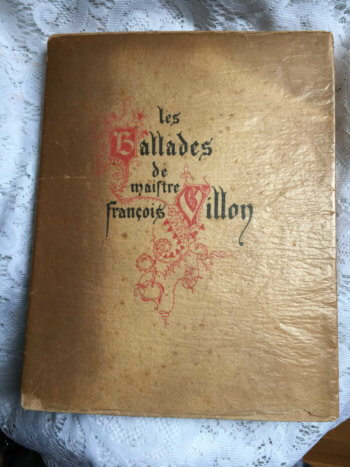 Les Ballades de Maistre Francois Villon, Francois Villon, illus. Chéri Hérouard, caligraphy ["escrites"] by Raymond de Rigné (chez Cres., Paris, 1919, #188/550 signed by Hérouard) 11.75" X 9.25", 169pp, original french wraps with glassine cover, 31 full page drawings by Hérouard plus 31 small vignette type illustrations. Beautifully printed on heavy deckle edged paper. good condition, all original, minor rubbing, slight foxing on outer pages, inner pages clean, rips in glassine cover at top and bottom of spine. François Villon (c. 1431_1464) was a French poet. Most of what is known about Villon has been gathered from legal records and gleaned from his own writings. He was a thief, killer, barroom brawler, and vagabond. He is perhaps best known for his Testaments and his Ballades. He was the most famous realist poet of the Middle Ages. Chéri Hérouard (1881 - 1961) was a French illustrator who was most famously known for his forty-five-year work for French society magazine, La Vie Parisienne. Under the pseudonym of Herric, he also created erotic and sadomasochistic illustrations for various books including the Kama Sutra.
Les Ballades de Maistre Francois Villon, Francois Villon, illus. Chéri Hérouard, caligraphy ["escrites"] by Raymond de Rigné (chez Cres., Paris, 1919, #188/550 signed by Hérouard) 11.75" X 9.25", 169pp, original french wraps with glassine cover, 31 full page drawings by Hérouard plus 31 small vignette type illustrations. Beautifully printed on heavy deckle edged paper. good condition, all original, minor rubbing, slight foxing on outer pages, inner pages clean, rips in glassine cover at top and bottom of spine. François Villon (c. 1431_1464) was a French poet. Most of what is known about Villon has been gathered from legal records and gleaned from his own writings. He was a thief, killer, barroom brawler, and vagabond. He is perhaps best known for his Testaments and his Ballades. He was the most famous realist poet of the Middle Ages. Chéri Hérouard (1881 - 1961) was a French illustrator who was most famously known for his forty-five-year work for French society magazine, La Vie Parisienne. Under the pseudonym of Herric, he also created erotic and sadomasochistic illustrations for various books including the Kama Sutra. -
 Die Abenteuer des Chevalier Faublas | Erzählt von Louvet de Couvray [[The adventures of the Chevalier Faublas | Told by Louvet de Couvray], etchings by Karl Walser (Georg Müller, Munich, 1910, #1411/1500) 8.25"x5.5", 4 volumes, x+216pp, 279pp, 295pp, 344pp, half calf over decorated silk (from a drawing by Karl Walser), black title and vol. label with gilt lettering and decorations on spine, 4 etched title vignettes and 12 toned etchings by Karl Walser on 12 panels with green tissue guard, ribbons present in all volumes, good+ condition. Karl Walser (1877-1943) was a Swiss painter, set designer and illustrator. His artwork, although very popular during his lifetime, has mostly been forgotten by the art world, unlike his brother, author Robert Walser, who was never able to support himself through writing which gained notoriety after his death. Jean-Baptiste Louvet de Couvrai (1760 - 1797) was born in Paris as the son of a stationer, he became a bookseller's clerk, and first attracted attention with the first part of his novel "Les Amours du chevalier de Faublas" (5 parts) in 1787; it was followed in 1788 by "Six semaines de la vie du chevalier de Faublas" (8 parts) and in 1790 by "La Fin des amours du chevalier de Faublas" (6 parts). The heroine, Lodoiska, was modeled on the wife of a jeweler in the Palais Royal, with whom he had an affair. She divorced her husband in 1792 and married Louvet in 1793. This is considered a so-called "libertine" novel. It dwells mainly on the sexual escapades of its hero, a sort of amiable young libertine, and on the corrupted morals of eighteenth-century France. At the start of this novel the young Chevalier de Faublas attends a party dressed as a woman and is knowingly seduced by the lady of the house ('. I receive with equal astonishment and pleasure a charming lesson, which I repeated more than once .') Oxford Comp. to French Literature says it is "typical of many frivolous, licentious novels of its time, and still mentioned. Faublas, the amiable hero, is the victim of his own charms. His amorous adventures, recounted with a certain lively force, begin with his entry into society at the age of sixteen. He loves several women by the way and three in particular. A jealous husband and a despairing suicide reduce the three to one. The novel ends on a moral note: Faublas , who had happened to settle down with his remaining love, is haunted by the avenging phantoms of the other two and goes mad."
Die Abenteuer des Chevalier Faublas | Erzählt von Louvet de Couvray [[The adventures of the Chevalier Faublas | Told by Louvet de Couvray], etchings by Karl Walser (Georg Müller, Munich, 1910, #1411/1500) 8.25"x5.5", 4 volumes, x+216pp, 279pp, 295pp, 344pp, half calf over decorated silk (from a drawing by Karl Walser), black title and vol. label with gilt lettering and decorations on spine, 4 etched title vignettes and 12 toned etchings by Karl Walser on 12 panels with green tissue guard, ribbons present in all volumes, good+ condition. Karl Walser (1877-1943) was a Swiss painter, set designer and illustrator. His artwork, although very popular during his lifetime, has mostly been forgotten by the art world, unlike his brother, author Robert Walser, who was never able to support himself through writing which gained notoriety after his death. Jean-Baptiste Louvet de Couvrai (1760 - 1797) was born in Paris as the son of a stationer, he became a bookseller's clerk, and first attracted attention with the first part of his novel "Les Amours du chevalier de Faublas" (5 parts) in 1787; it was followed in 1788 by "Six semaines de la vie du chevalier de Faublas" (8 parts) and in 1790 by "La Fin des amours du chevalier de Faublas" (6 parts). The heroine, Lodoiska, was modeled on the wife of a jeweler in the Palais Royal, with whom he had an affair. She divorced her husband in 1792 and married Louvet in 1793. This is considered a so-called "libertine" novel. It dwells mainly on the sexual escapades of its hero, a sort of amiable young libertine, and on the corrupted morals of eighteenth-century France. At the start of this novel the young Chevalier de Faublas attends a party dressed as a woman and is knowingly seduced by the lady of the house ('. I receive with equal astonishment and pleasure a charming lesson, which I repeated more than once .') Oxford Comp. to French Literature says it is "typical of many frivolous, licentious novels of its time, and still mentioned. Faublas, the amiable hero, is the victim of his own charms. His amorous adventures, recounted with a certain lively force, begin with his entry into society at the age of sixteen. He loves several women by the way and three in particular. A jealous husband and a despairing suicide reduce the three to one. The novel ends on a moral note: Faublas , who had happened to settle down with his remaining love, is haunted by the avenging phantoms of the other two and goes mad." -
 L'histoire comique de Francion en laquelle sont découvertes les plus subtiles finesses et trompeuses inventions tant des hommes que des femmes de toute sortes de conditions et d'âges. Non moins profitable pour s'en garder, que plaisante à la lecture., Charles Sorel, illus. Martin van Maele (chez Jean Fort, Paris, 1925 #131/ 1100 of copies made with pure Enoshima fibre paper) 9″x6″, 411pp, quarter-bound calf over slate boards, 5 raised bands, gilt titles and decorations on spine, top-edge gilt others deckled, fair condition, boards very loose, barely holding Charles Sorel, sieur de Souvigny (1602 –1674) was a French novelist and general writer. Very little is known of his life except that in 1635 he was historiographer of France. He wrote on science, history and religion, but is only remembered for his novels. He tried to destroy the vogue for the pastoral romance by writing a novel of adventure, the Histoire comique de Francion (first edition in seven volumes, 1623; second edition in twelve volumes, 1633). The episodical adventures of Francion found many readers, who nevertheless kept their admiration for Honoré d'Urfé's L'Astrée, which it was intended to ridicule.
L'histoire comique de Francion en laquelle sont découvertes les plus subtiles finesses et trompeuses inventions tant des hommes que des femmes de toute sortes de conditions et d'âges. Non moins profitable pour s'en garder, que plaisante à la lecture., Charles Sorel, illus. Martin van Maele (chez Jean Fort, Paris, 1925 #131/ 1100 of copies made with pure Enoshima fibre paper) 9″x6″, 411pp, quarter-bound calf over slate boards, 5 raised bands, gilt titles and decorations on spine, top-edge gilt others deckled, fair condition, boards very loose, barely holding Charles Sorel, sieur de Souvigny (1602 –1674) was a French novelist and general writer. Very little is known of his life except that in 1635 he was historiographer of France. He wrote on science, history and religion, but is only remembered for his novels. He tried to destroy the vogue for the pastoral romance by writing a novel of adventure, the Histoire comique de Francion (first edition in seven volumes, 1623; second edition in twelve volumes, 1633). The episodical adventures of Francion found many readers, who nevertheless kept their admiration for Honoré d'Urfé's L'Astrée, which it was intended to ridicule. -
Out of stock
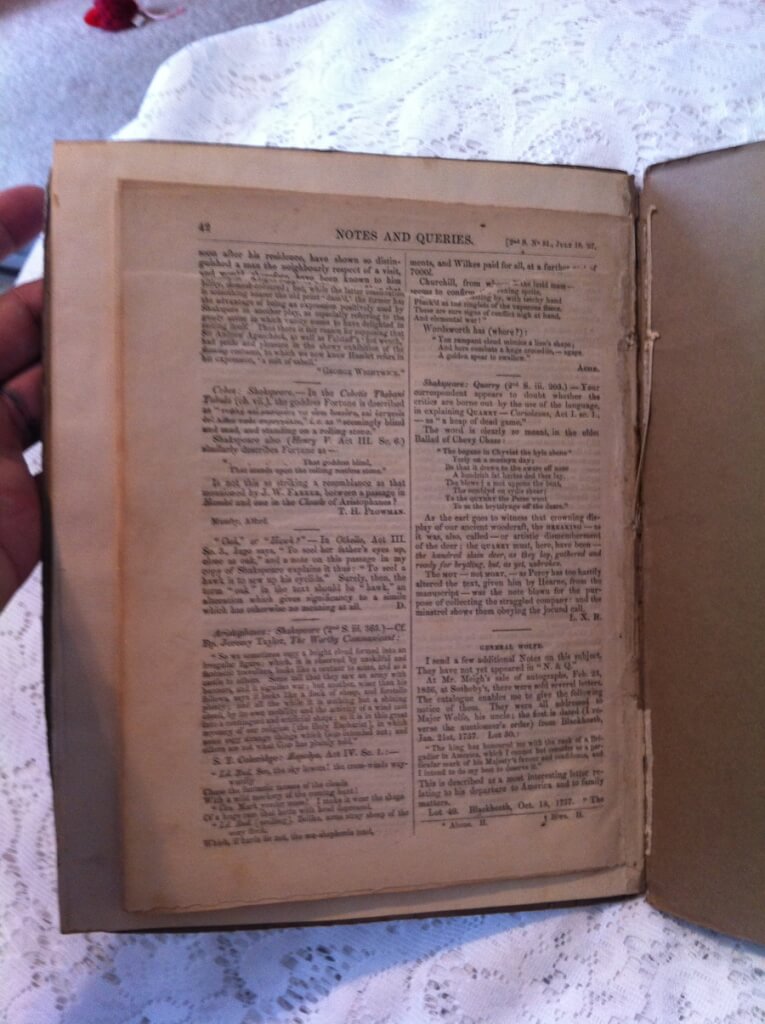
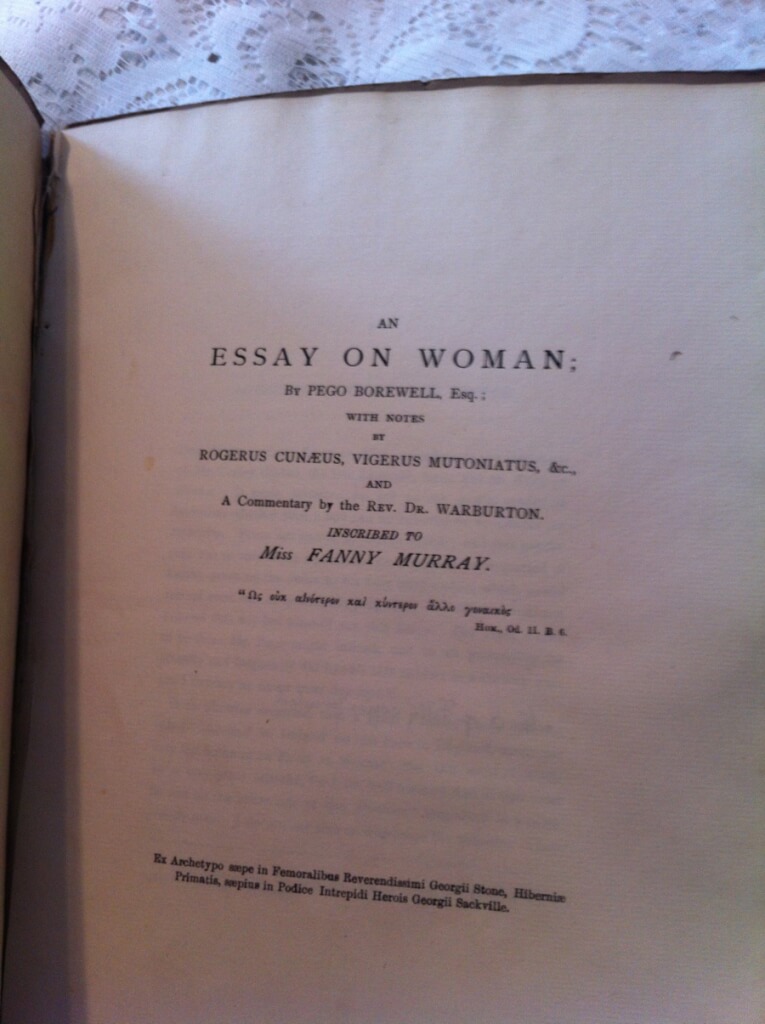 An Essay on Woman, by Pego Borewell, Esq., "with notes by Rogerus Cuneaus, Vigerus Mutoniatus, & Co. and A Commentary by the Rev. Dr. Warburton, inscribed to Miss Fanny Murray (np, bibliography on last page dated 1883) 7.5" X 9.75", 24pp., original soft wraps appear to be enclosed in brown wrap, appear to be two pages cut out before the title page, articles from "Notes and Queries" (dating July 11, 1857 and July 18, 1857) pasted into back of the book, followed by notes on legal paper from previous owner presumably trying to verify this edition Sometime in 1755, John Wilkes, together with fellow rake and son of the Archbishop of Cantebury, Thomas Potter (c. 1718-1759), composed a bawdy set of parodied Alexander Pope poems entitled An Essay on Woman, a satirical imitation of Pope's An Essay on Man. In 1763 he was put in jail for political reasons ("seditious libel for his anti-Jacobite smearing which appeared in his 'radical' weekly publication"). Upon release, his home was unlawfully searched and proofs of his "Essay on Woman" was discovered. This is an unknown reprint, as no original is known. I am still researching.
An Essay on Woman, by Pego Borewell, Esq., "with notes by Rogerus Cuneaus, Vigerus Mutoniatus, & Co. and A Commentary by the Rev. Dr. Warburton, inscribed to Miss Fanny Murray (np, bibliography on last page dated 1883) 7.5" X 9.75", 24pp., original soft wraps appear to be enclosed in brown wrap, appear to be two pages cut out before the title page, articles from "Notes and Queries" (dating July 11, 1857 and July 18, 1857) pasted into back of the book, followed by notes on legal paper from previous owner presumably trying to verify this edition Sometime in 1755, John Wilkes, together with fellow rake and son of the Archbishop of Cantebury, Thomas Potter (c. 1718-1759), composed a bawdy set of parodied Alexander Pope poems entitled An Essay on Woman, a satirical imitation of Pope's An Essay on Man. In 1763 he was put in jail for political reasons ("seditious libel for his anti-Jacobite smearing which appeared in his 'radical' weekly publication"). Upon release, his home was unlawfully searched and proofs of his "Essay on Woman" was discovered. This is an unknown reprint, as no original is known. I am still researching. -
 The Ragionamenti or dialogues of the devine Pietro Aretino, Pietro Aretino, trans. Isidore Liseux (Isidore Liseux, Paris, 1889) 8" X 6", 3 volumes, xxxv+83+89pp, 100+134pp, 129+138pp, half-bound brown morocco over marbled boards, gilt titles on spines, top-edge gilt, other edges deckled, each book has the ex-libris of Boies Penrose II Pietro Aretino (1492-1556) was one of the most important figures in Italian Renaissance literature, and certainly the most controversial. Condemned by some as a pornographer, his infamy was due largely to his use of explicit sexuality and the vulgar tongue of ordinary speech in much of his work. Dialogues center around a conversation between two rather frank, experienced, and sharp-tongued women on the topic of women’s occupations. We learn that at the time there were only three: wife, whore, or nun. Their discussion is a rollicking account of the advantages, perils, and pleasures each profession offers. Not only was Dialogues the first erotic book in the Christian world to be written in the common vernacular, it was but one of the few to describe the obscenity of commercial love, and is thus a cornerstone of both Italian literature and Counter-Renaissance vigour. First dialog: The Life of Nuns Second dialog: The Life of Married Women Third dialog: The Life of Courtesans Fourth dialog: The Education of Pippa Fifth dialog: The Wiles of Men Sixth dialog: The Bawd’s Trade Isidore Liseux (1835-1894) was a French bibliophile and publisher of erotica and curiosa. His publications were mostly rare texts of 16th to 18th century authors, hard to find and little known books which were usually translated and annotated by his friend and associate Alcide Bonneau or by Liseux himself. Liseux and Bonneau, both ex-priests, knew each other since seminary. His books were published in small numbers, on high quality paper, and with excellent typography. His usual printers were Claude Motteroz, Antoine Bécus, and later Charles Unsinger. Liseux’s books were published openly as the climate was more permissive in Paris at the time. His books were so well regarded that pirates of his books and even unrelated books bearing his imprint with a false date were published clandestinely into the 20th century. French poet, Guillaume Apollinaire wrote: “The publications of Liseux are more and more sought after because they are correct, beautiful and rare.” (Le flaneur des deux rives, 1918). Time Magazine, Monday, May 11, 1936 Youngish Pennsylvanians whose Progressive fathers frightened them with the name of BOIES PENROSE a quarter century ago could look forward last week to bemusing their own children with that great name some day. In Philadelphia Boies Penrose II, nephew of Pennsylvania's longtime (1897-1921) Senator and Republican boss, received a Republican nomination to Congress in last week's primary. A rich and cultured Harvard man like his late uncle, 34-year-old Boies II has hitherto devoted himself to scholarship and society, is the owner of a notable collection of etchings, engravings, manuscripts and rare books. When he decided few months ago to make a career for himself in politics, leaders of Philadelphia's Republican machine warmly welcomed a young man with so potent a name, so fat a pocketbook. Candidate Penrose, who owns a 125-acre estate on the Main Line at swank Devon where he takes his own and neighbors' small children for rides on his mile-long miniature railroad, promptly established a residence in Philadelphia by renting an apartment, the address of which he is constantly forgetting.— "My platform," he announced in fastidious Bostonese, "will be the Horse & Buggy, or Save the Constitution." In the Republican split of 1912 Boies Penrose temporarily lost his State leadership to the Bull Moose faction, which included an ardent Young Roosevelt worshipper named Gifford Pinchot. While one set of Philadelphia voters was lifting the name of Penrose up last week, another group was setting the name of Pinchot down. In a district inhabited largely by factory workers whose cause she has championed many a time on the picket line, red-haired Mrs. Gifford Pinchot made her third race for a Republican nomination to the House, suffered her third defeat.
The Ragionamenti or dialogues of the devine Pietro Aretino, Pietro Aretino, trans. Isidore Liseux (Isidore Liseux, Paris, 1889) 8" X 6", 3 volumes, xxxv+83+89pp, 100+134pp, 129+138pp, half-bound brown morocco over marbled boards, gilt titles on spines, top-edge gilt, other edges deckled, each book has the ex-libris of Boies Penrose II Pietro Aretino (1492-1556) was one of the most important figures in Italian Renaissance literature, and certainly the most controversial. Condemned by some as a pornographer, his infamy was due largely to his use of explicit sexuality and the vulgar tongue of ordinary speech in much of his work. Dialogues center around a conversation between two rather frank, experienced, and sharp-tongued women on the topic of women’s occupations. We learn that at the time there were only three: wife, whore, or nun. Their discussion is a rollicking account of the advantages, perils, and pleasures each profession offers. Not only was Dialogues the first erotic book in the Christian world to be written in the common vernacular, it was but one of the few to describe the obscenity of commercial love, and is thus a cornerstone of both Italian literature and Counter-Renaissance vigour. First dialog: The Life of Nuns Second dialog: The Life of Married Women Third dialog: The Life of Courtesans Fourth dialog: The Education of Pippa Fifth dialog: The Wiles of Men Sixth dialog: The Bawd’s Trade Isidore Liseux (1835-1894) was a French bibliophile and publisher of erotica and curiosa. His publications were mostly rare texts of 16th to 18th century authors, hard to find and little known books which were usually translated and annotated by his friend and associate Alcide Bonneau or by Liseux himself. Liseux and Bonneau, both ex-priests, knew each other since seminary. His books were published in small numbers, on high quality paper, and with excellent typography. His usual printers were Claude Motteroz, Antoine Bécus, and later Charles Unsinger. Liseux’s books were published openly as the climate was more permissive in Paris at the time. His books were so well regarded that pirates of his books and even unrelated books bearing his imprint with a false date were published clandestinely into the 20th century. French poet, Guillaume Apollinaire wrote: “The publications of Liseux are more and more sought after because they are correct, beautiful and rare.” (Le flaneur des deux rives, 1918). Time Magazine, Monday, May 11, 1936 Youngish Pennsylvanians whose Progressive fathers frightened them with the name of BOIES PENROSE a quarter century ago could look forward last week to bemusing their own children with that great name some day. In Philadelphia Boies Penrose II, nephew of Pennsylvania's longtime (1897-1921) Senator and Republican boss, received a Republican nomination to Congress in last week's primary. A rich and cultured Harvard man like his late uncle, 34-year-old Boies II has hitherto devoted himself to scholarship and society, is the owner of a notable collection of etchings, engravings, manuscripts and rare books. When he decided few months ago to make a career for himself in politics, leaders of Philadelphia's Republican machine warmly welcomed a young man with so potent a name, so fat a pocketbook. Candidate Penrose, who owns a 125-acre estate on the Main Line at swank Devon where he takes his own and neighbors' small children for rides on his mile-long miniature railroad, promptly established a residence in Philadelphia by renting an apartment, the address of which he is constantly forgetting.— "My platform," he announced in fastidious Bostonese, "will be the Horse & Buggy, or Save the Constitution." In the Republican split of 1912 Boies Penrose temporarily lost his State leadership to the Bull Moose faction, which included an ardent Young Roosevelt worshipper named Gifford Pinchot. While one set of Philadelphia voters was lifting the name of Penrose up last week, another group was setting the name of Pinchot down. In a district inhabited largely by factory workers whose cause she has championed many a time on the picket line, red-haired Mrs. Gifford Pinchot made her third race for a Republican nomination to the House, suffered her third defeat. -
 The 120 Days of Sodom or: The Romance of The School for Libertinage | Being an English rendering of Les 120 Journées de Sodome done by Pieralessandro Casavini, with an Essay by Georges Bataille, D.A.F. de Sade, trans. Pieralessandro Casavini [Austryn Wainhouse] (Olympia Press, Paris, 1957, Traveller's Companion Series) 7" X 4.5", 3 vol. 192pp 203pp 224pp, original green soft wraps, good condition for age, some bumping and small tears to spine, slight soiling. The 120 Days of Sodom, or the School of Libertinage (French: Les 120 Journées de Sodome ou l'école du libertinage) is an unfinished novel by the French writer and nobleman Donatien Alphonse François, Marquis de Sade, written in 1785. Its plot revolves around the activities of four wealthy libertine men who spend four months seeking out the ultimate sexual gratification through orgies, sealing themselves away in an inaccessible castle in the heart of the Black Forest in Germany with four madams and a harem of thirty-six victims, mostly male and female teenagers. The madams relate stories of their most memorable clients, whose crimes and tortures inspire the libertines to likewise and increasingly abuse and torture their victims to their eventual deaths. Sade states he wrote The 120 Days of Sodom over 37 days in 1785 while he was imprisoned in the Bastille. Being short of writing materials and fearing confiscation, he wrote it in tiny writing on a continuous roll of paper, made up of individual small pieces of paper smuggled into the prison and glued together. The result was a scroll 12 metres long that Sade would hide by rolling it tightly and placing it inside his cell wall. Sade incited a riot among the people gathered outside when he shouted to them that the guards were murdering inmates; as a result, two days later on 4 July 1789, he was transferred to the asylum at Charenton, "naked as a worm" and unable to retrieve the novel in progress. Sade believed the work was destroyed when the Bastille was stormed and looted on 14 July 1789, at the beginning of the French Revolution. He was distraught over its loss and wrote that he "wept tears of blood" in his grief. However, the long scroll of paper on which it was written was found hidden in the walls of his cell where Sade had left it, and removed by a citizen named Arnoux de Saint-Maximin two days before the storming. Historians know little about Saint-Maximin or why he took the manuscript. It was first discovered and published in 1904 by the Berlin dermatologist, psychiatrist, and sexologist Iwan Bloch (who used a pseudonym, "Dr. Eugen Dühren", to avoid controversy). Olympia Press was a Paris-based publisher, launched in 1953 by Maurice Girodias as a rebranded version of the Obelisk Press he inherited from his father Jack Kahane. It published a mix of erotic fiction and avant-garde literary fiction, and is best known for issuing the first printed edition of Vladimir Nabokov's Lolita. In its heyday during the mid-fifties Olympia Press specialized in books which could not be published (without legal action) in the English-speaking world. Early on, Girodias relied on the permissive attitudes of the French to publish sexually explicit books in both French and English. The French began to ban and seize the press's book in the late fifties. Precisely 94 Olympia Press publications were promoted and packaged as "Traveller's Companion" books, usually with simple text-only covers, and each book in the series was numbered. The "Ophelia Press" line of erotica was far larger, using the same design, but pink covers instead of green. In Olympia Press was the first to translate this work into English. "120 Days of Sodom" was first published 1954 (pink covers), and then again in their "Traveller's Companion Series" in 1957 which is this edition.
The 120 Days of Sodom or: The Romance of The School for Libertinage | Being an English rendering of Les 120 Journées de Sodome done by Pieralessandro Casavini, with an Essay by Georges Bataille, D.A.F. de Sade, trans. Pieralessandro Casavini [Austryn Wainhouse] (Olympia Press, Paris, 1957, Traveller's Companion Series) 7" X 4.5", 3 vol. 192pp 203pp 224pp, original green soft wraps, good condition for age, some bumping and small tears to spine, slight soiling. The 120 Days of Sodom, or the School of Libertinage (French: Les 120 Journées de Sodome ou l'école du libertinage) is an unfinished novel by the French writer and nobleman Donatien Alphonse François, Marquis de Sade, written in 1785. Its plot revolves around the activities of four wealthy libertine men who spend four months seeking out the ultimate sexual gratification through orgies, sealing themselves away in an inaccessible castle in the heart of the Black Forest in Germany with four madams and a harem of thirty-six victims, mostly male and female teenagers. The madams relate stories of their most memorable clients, whose crimes and tortures inspire the libertines to likewise and increasingly abuse and torture their victims to their eventual deaths. Sade states he wrote The 120 Days of Sodom over 37 days in 1785 while he was imprisoned in the Bastille. Being short of writing materials and fearing confiscation, he wrote it in tiny writing on a continuous roll of paper, made up of individual small pieces of paper smuggled into the prison and glued together. The result was a scroll 12 metres long that Sade would hide by rolling it tightly and placing it inside his cell wall. Sade incited a riot among the people gathered outside when he shouted to them that the guards were murdering inmates; as a result, two days later on 4 July 1789, he was transferred to the asylum at Charenton, "naked as a worm" and unable to retrieve the novel in progress. Sade believed the work was destroyed when the Bastille was stormed and looted on 14 July 1789, at the beginning of the French Revolution. He was distraught over its loss and wrote that he "wept tears of blood" in his grief. However, the long scroll of paper on which it was written was found hidden in the walls of his cell where Sade had left it, and removed by a citizen named Arnoux de Saint-Maximin two days before the storming. Historians know little about Saint-Maximin or why he took the manuscript. It was first discovered and published in 1904 by the Berlin dermatologist, psychiatrist, and sexologist Iwan Bloch (who used a pseudonym, "Dr. Eugen Dühren", to avoid controversy). Olympia Press was a Paris-based publisher, launched in 1953 by Maurice Girodias as a rebranded version of the Obelisk Press he inherited from his father Jack Kahane. It published a mix of erotic fiction and avant-garde literary fiction, and is best known for issuing the first printed edition of Vladimir Nabokov's Lolita. In its heyday during the mid-fifties Olympia Press specialized in books which could not be published (without legal action) in the English-speaking world. Early on, Girodias relied on the permissive attitudes of the French to publish sexually explicit books in both French and English. The French began to ban and seize the press's book in the late fifties. Precisely 94 Olympia Press publications were promoted and packaged as "Traveller's Companion" books, usually with simple text-only covers, and each book in the series was numbered. The "Ophelia Press" line of erotica was far larger, using the same design, but pink covers instead of green. In Olympia Press was the first to translate this work into English. "120 Days of Sodom" was first published 1954 (pink covers), and then again in their "Traveller's Companion Series" in 1957 which is this edition. -

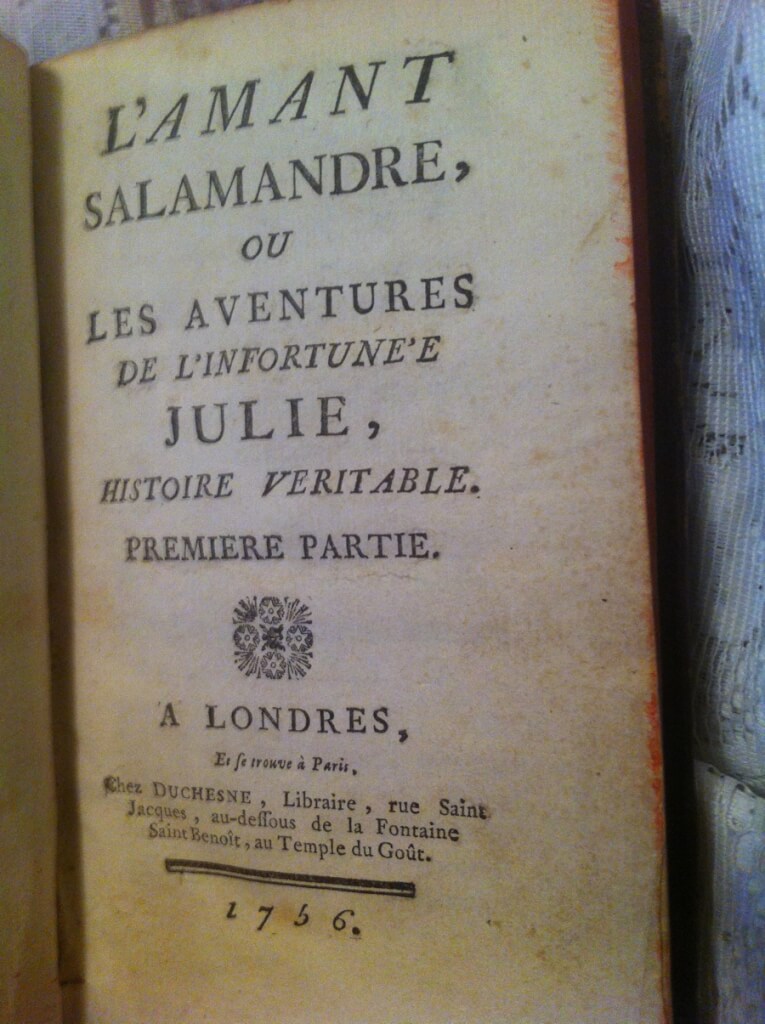 L'Amant Salamandre, ou Les Aventures de l'Infortunée Julie,Histoire Veritable, anonymous [Cointreau] , ("Londres, Et se trouve à Paris. Chez Duchesne" 1756, [first edition]) 4"x6.75", in two parts, 132pp, 135pp, Contemporary mottled calf, gilt decorations on spine, marbled boards, in good condition for age, some splitting at spine, but binding good. Julie is the bizarre tale of a young orphan tricked by her wicked governess into believing in magic. The governess delivers the girl to her son, who attempts to seduce her disguised as Salamandre, a magician. The young girl escapes to a convent, only to cross paths with the governess some time later, who once again tries to procure her for her son. 'Salamandre' is attacked by assassins and confesses his mother's crimes on his death bed. The novel was very popular in it's day. Although very popular in it's day, it's a rare find, especially the original 1756 version.
L'Amant Salamandre, ou Les Aventures de l'Infortunée Julie,Histoire Veritable, anonymous [Cointreau] , ("Londres, Et se trouve à Paris. Chez Duchesne" 1756, [first edition]) 4"x6.75", in two parts, 132pp, 135pp, Contemporary mottled calf, gilt decorations on spine, marbled boards, in good condition for age, some splitting at spine, but binding good. Julie is the bizarre tale of a young orphan tricked by her wicked governess into believing in magic. The governess delivers the girl to her son, who attempts to seduce her disguised as Salamandre, a magician. The young girl escapes to a convent, only to cross paths with the governess some time later, who once again tries to procure her for her son. 'Salamandre' is attacked by assassins and confesses his mother's crimes on his death bed. The novel was very popular in it's day. Although very popular in it's day, it's a rare find, especially the original 1756 version. -
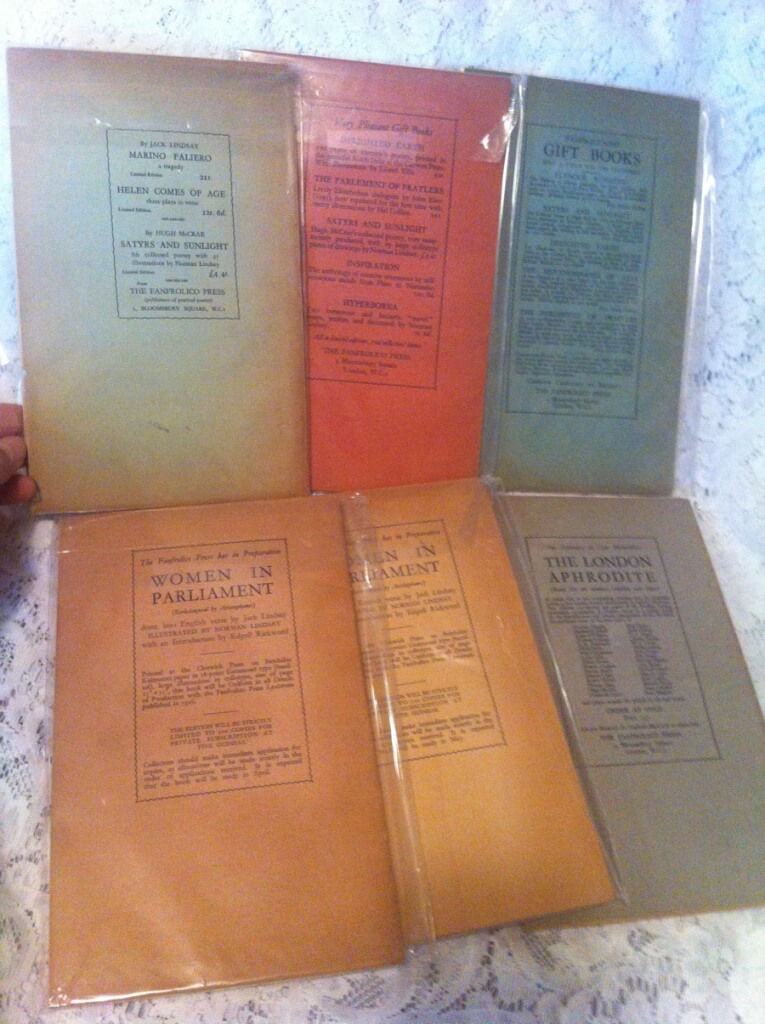
 The London Aphrodite, ed. Jack Lindsay and P.R. Stephensen (Fanfrolico Press, "printed by the Botolph Printing Works", London, 1928 - 29) 9.75" X 6.25", 496pp numbered sequentially throughout series, v1 1-64, v2 45-160, v3 161-232, v4 233-316, v5 317-400, v6 401-496, full set of 6 planned issues, great condition for age, the expected sunning/fading from soft-cover periodical of this era, small ink price stamp to front of v1. A periodical edited by Jack Lindsay and P.R. Stephensen and published in London by the Fanfrolico Press, ran bi-monthly for a planned six issues August 1928 - June 29. Self-described as "A Miscellany of Poems Stories and Essays by Various Hands Eminent or Rebellious." Named as a rebuttal of the conservatism of J.C. Squire's London Mercury, it was committed to the same aesthetic attitudes as Vision. Some prominent writers, including Aldous Huxley, Norman Lindsay, Robert Nichols, Liam O'Flaherty, Edward Marsh, Edward Marsh, Norman Douglas, Stanley Snaith, Alexander Blok, Hugh McCrae, Kenneth Slessor, Philip Lindsay, Brian Penton, P.R. Stephensen, Les Robinson, W.J. Turner, Bertram Higgins, E.J. Rupert Atkinson, Sacheverell Sitwell, T.F. Powys, Rhys Davides, and Edith Hepburn ('Anna Wickham'). Jack Lindsay, the dominant force, used the pseudonym 'Peter Meadows' for several articles. Fanfrolico Press, Australia’s first ‘private press’ in the arts-and-craft tradition, was founded by Jack Lindsay, P. R. Stephensen and John Kirtley, originally in North Sydney in 1923. The press specialized in printings artful, limited editions of classics and forgotten works that were suited to the extravagant style of artist like his father, artist, sculptor and author Norman Lindsay who illustrated many of their books. Fanfrolico was scornful of modernism and with its florid style determinedly backward-looking. They did surprisingly well, despite the lack of business expertise of their young, ambitious "bohemian" owners, eking out a living despite the risky move to London in 1926 and upheavals in ownership that saw the departure in 1927 of Kirtley, and then Stephenson in 1929. Sometime in 1930 they published their last book.
The London Aphrodite, ed. Jack Lindsay and P.R. Stephensen (Fanfrolico Press, "printed by the Botolph Printing Works", London, 1928 - 29) 9.75" X 6.25", 496pp numbered sequentially throughout series, v1 1-64, v2 45-160, v3 161-232, v4 233-316, v5 317-400, v6 401-496, full set of 6 planned issues, great condition for age, the expected sunning/fading from soft-cover periodical of this era, small ink price stamp to front of v1. A periodical edited by Jack Lindsay and P.R. Stephensen and published in London by the Fanfrolico Press, ran bi-monthly for a planned six issues August 1928 - June 29. Self-described as "A Miscellany of Poems Stories and Essays by Various Hands Eminent or Rebellious." Named as a rebuttal of the conservatism of J.C. Squire's London Mercury, it was committed to the same aesthetic attitudes as Vision. Some prominent writers, including Aldous Huxley, Norman Lindsay, Robert Nichols, Liam O'Flaherty, Edward Marsh, Edward Marsh, Norman Douglas, Stanley Snaith, Alexander Blok, Hugh McCrae, Kenneth Slessor, Philip Lindsay, Brian Penton, P.R. Stephensen, Les Robinson, W.J. Turner, Bertram Higgins, E.J. Rupert Atkinson, Sacheverell Sitwell, T.F. Powys, Rhys Davides, and Edith Hepburn ('Anna Wickham'). Jack Lindsay, the dominant force, used the pseudonym 'Peter Meadows' for several articles. Fanfrolico Press, Australia’s first ‘private press’ in the arts-and-craft tradition, was founded by Jack Lindsay, P. R. Stephensen and John Kirtley, originally in North Sydney in 1923. The press specialized in printings artful, limited editions of classics and forgotten works that were suited to the extravagant style of artist like his father, artist, sculptor and author Norman Lindsay who illustrated many of their books. Fanfrolico was scornful of modernism and with its florid style determinedly backward-looking. They did surprisingly well, despite the lack of business expertise of their young, ambitious "bohemian" owners, eking out a living despite the risky move to London in 1926 and upheavals in ownership that saw the departure in 1927 of Kirtley, and then Stephenson in 1929. Sometime in 1930 they published their last book. -
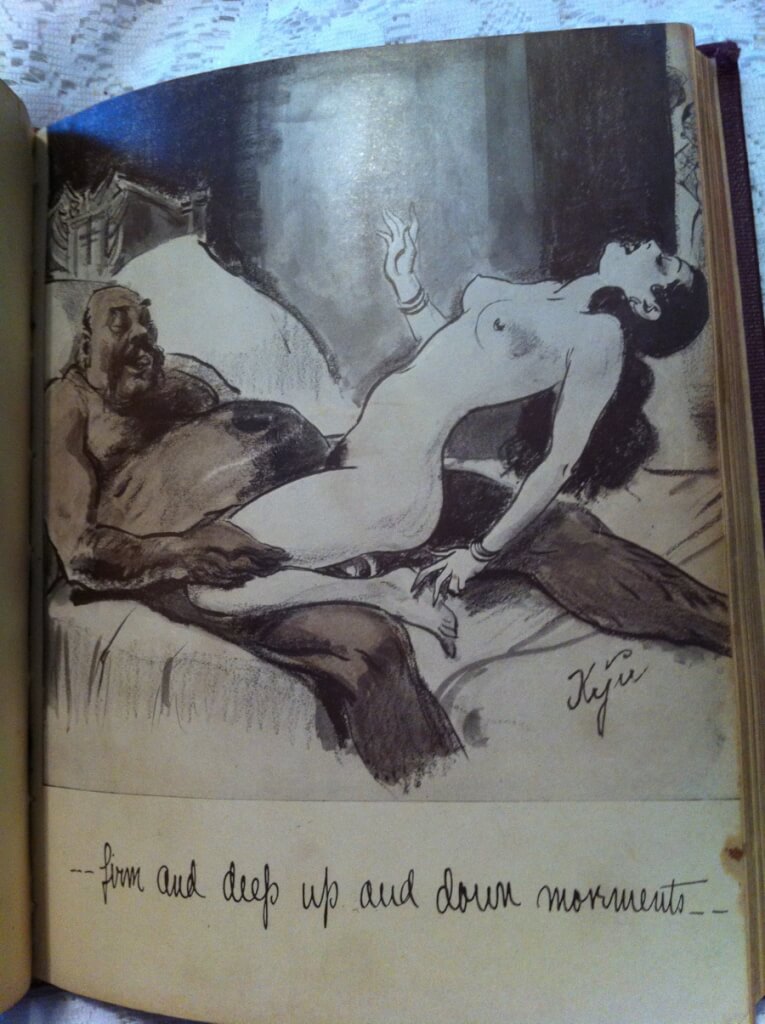
 Three Times a Woman, Grushenka, anonymous [possibly Val Lewton?], illus. "a young Russian residing in Paris, who unfortunately must remain anonymous" (Privately Printed, London [New York], 1933) 9" X 7", 252pp, hardbound no DJ, red boards with gilt title on cover and spine, good condition, minor wear and bumping. Title page reads: "The Story of a Russian Serf Girl Compiled from Contemporary Documents in the Russian Police Files and Private Archives of Russian Libraries" Originally published at New York in 1933 with a false Paris imprint. Val Lewton, the supposed author, was a well known film producer, responsible for a series of good low-budget horror movies in the 1940's by such directors as Robert Wise, Mark Robson and Jacques Tourneur. The book purports to be a flaggelation story written by a Russian living in Paris and then translated to english. The story takes place c. 1728, "shortly after the death of Peter the Great". The main character is Grushenka Pavlovsk. This edition is complete with very explicit illustrations.
Three Times a Woman, Grushenka, anonymous [possibly Val Lewton?], illus. "a young Russian residing in Paris, who unfortunately must remain anonymous" (Privately Printed, London [New York], 1933) 9" X 7", 252pp, hardbound no DJ, red boards with gilt title on cover and spine, good condition, minor wear and bumping. Title page reads: "The Story of a Russian Serf Girl Compiled from Contemporary Documents in the Russian Police Files and Private Archives of Russian Libraries" Originally published at New York in 1933 with a false Paris imprint. Val Lewton, the supposed author, was a well known film producer, responsible for a series of good low-budget horror movies in the 1940's by such directors as Robert Wise, Mark Robson and Jacques Tourneur. The book purports to be a flaggelation story written by a Russian living in Paris and then translated to english. The story takes place c. 1728, "shortly after the death of Peter the Great". The main character is Grushenka Pavlovsk. This edition is complete with very explicit illustrations. -
 Die Weiberherrschaft in der Geschichte der Menschheit [The Rule of Women in the History of Mankind], Eduard Fuchs, Alfred Kind (Albert Langen, München, 1913) 8.75″ X 11″, complete set, 2 volumes plus supplementary volume, x+1-348pp, 349-711pp, ix+319pp, decorated green cloth boards, decorated cloth endpapers, binding loose by design and very much intact on all volumes (binding is often a problem with this edition), Vol. 1&2 contain 665 illustrations and 90 tipped in illustrations. The supplemental volume contains 317 illustrations and 34 tipped in illustrations. Minor bumping on covers, in excellent condition for age. Compiling 665+317 reproductions of drawings, prints and paintings from the collection of Eduard Fuchs, this edition shows how the image of female domination and male submission was widespread in Europe from the Renaissance to the early 20th century. Edward Fuchs (1870-1940). Fuchs' father was a shopkeeper. Early in his life, the younger Fuchs developed socialist and Marxist political convictions. In 1886, he joined the outlawed political party Sozialistische Arbeiterpartei (the precursor of the modern SPD, Sozialdemokratische Partei Deutschlands). Fuchs received a doctor of law degree and practiced as an attorney. In 1892, he became editor-in-chief of the satiric weekly Süddeutscher Postillon and later co-editor of the Leipziger Volkszeitung. His inflammatory articles in newspapers—one accusing the Kaiser of being a mass murderer—resulted in periodic jail sentences. During his periods of confinement, Fuchs wrote various social histories utilizing images as one of his primary sources. The first of these was his Karikatur der europäischen Völker (Caricatures of European Peoples), 1902. He moved to Berlin that same year where he edited the socialist newspaper Vorwärts. The following year he began his magnum opus, an examination of moral practice, Sittengeschichte, eventually running to six volumes by 1912. While engaged in this series, he followed up his interest in caricatures with one devoted to the representation of women, Die Frau in der Karikatur, 1905 (3 vols). Another book documenting the stereotypical representations of Jews appeared in 1912. Fuchs traveled with the artist Max Slevogt to Egypt in 1914, shortly before the outbreak of World War I. He was a pacifist during the War. Lenin's government put him in charge of prisoner exchange with Germany after the war; he was among the leaders of the German Comintern in Berlin in 1919. His interest in societal concerns in caricature led to a research interest in Daumier. Beginning in 1920, Fuchs published a catalogue raisonné on the artist in three volumes. He resigned from the party in 1929, following the expulsion of several stalwarts. At Hitler's ascension to power in Germany in 1933, Fuchs moved to France.
Die Weiberherrschaft in der Geschichte der Menschheit [The Rule of Women in the History of Mankind], Eduard Fuchs, Alfred Kind (Albert Langen, München, 1913) 8.75″ X 11″, complete set, 2 volumes plus supplementary volume, x+1-348pp, 349-711pp, ix+319pp, decorated green cloth boards, decorated cloth endpapers, binding loose by design and very much intact on all volumes (binding is often a problem with this edition), Vol. 1&2 contain 665 illustrations and 90 tipped in illustrations. The supplemental volume contains 317 illustrations and 34 tipped in illustrations. Minor bumping on covers, in excellent condition for age. Compiling 665+317 reproductions of drawings, prints and paintings from the collection of Eduard Fuchs, this edition shows how the image of female domination and male submission was widespread in Europe from the Renaissance to the early 20th century. Edward Fuchs (1870-1940). Fuchs' father was a shopkeeper. Early in his life, the younger Fuchs developed socialist and Marxist political convictions. In 1886, he joined the outlawed political party Sozialistische Arbeiterpartei (the precursor of the modern SPD, Sozialdemokratische Partei Deutschlands). Fuchs received a doctor of law degree and practiced as an attorney. In 1892, he became editor-in-chief of the satiric weekly Süddeutscher Postillon and later co-editor of the Leipziger Volkszeitung. His inflammatory articles in newspapers—one accusing the Kaiser of being a mass murderer—resulted in periodic jail sentences. During his periods of confinement, Fuchs wrote various social histories utilizing images as one of his primary sources. The first of these was his Karikatur der europäischen Völker (Caricatures of European Peoples), 1902. He moved to Berlin that same year where he edited the socialist newspaper Vorwärts. The following year he began his magnum opus, an examination of moral practice, Sittengeschichte, eventually running to six volumes by 1912. While engaged in this series, he followed up his interest in caricatures with one devoted to the representation of women, Die Frau in der Karikatur, 1905 (3 vols). Another book documenting the stereotypical representations of Jews appeared in 1912. Fuchs traveled with the artist Max Slevogt to Egypt in 1914, shortly before the outbreak of World War I. He was a pacifist during the War. Lenin's government put him in charge of prisoner exchange with Germany after the war; he was among the leaders of the German Comintern in Berlin in 1919. His interest in societal concerns in caricature led to a research interest in Daumier. Beginning in 1920, Fuchs published a catalogue raisonné on the artist in three volumes. He resigned from the party in 1929, following the expulsion of several stalwarts. At Hitler's ascension to power in Germany in 1933, Fuchs moved to France. -
 The Golden Ass of Apuleius, Lucius Apuleius Madaurensis (124-170 AD), trans. & intro Francis D. Byrne (The Imperial Press[Charles Carrington?], London, n.d. [1904?], #257/650) 7.75" X 5.75", xlix+388pp., 1/4 maroon morrocco over marbled boards with gilt titles and 4 raised bands on spine, top edge gilt The Metamorphoses of Apuleius, which St. Augustine referred to as “The Golden Ass”, is the only Ancient Roman novel in Latin to survive in its entirety. The plot Lucius and his curiosity and insatiable desire to see and practice magic. While trying to perform a spell to transform into a bird, he is accidentally transformed into an ass. This leads to a long journey, literal and metaphorical, filled with in-set tales. He finally finds salvation through the intervention of the goddess Isis, whose cult he joins. The date of the original work is uncertain. Scholars are not sure if he wrote it in his youth or at the end of his life. He adapted the story from a Greek story written by Lucius of Patrae, however his original Greek text has long been lost.
The Golden Ass of Apuleius, Lucius Apuleius Madaurensis (124-170 AD), trans. & intro Francis D. Byrne (The Imperial Press[Charles Carrington?], London, n.d. [1904?], #257/650) 7.75" X 5.75", xlix+388pp., 1/4 maroon morrocco over marbled boards with gilt titles and 4 raised bands on spine, top edge gilt The Metamorphoses of Apuleius, which St. Augustine referred to as “The Golden Ass”, is the only Ancient Roman novel in Latin to survive in its entirety. The plot Lucius and his curiosity and insatiable desire to see and practice magic. While trying to perform a spell to transform into a bird, he is accidentally transformed into an ass. This leads to a long journey, literal and metaphorical, filled with in-set tales. He finally finds salvation through the intervention of the goddess Isis, whose cult he joins. The date of the original work is uncertain. Scholars are not sure if he wrote it in his youth or at the end of his life. He adapted the story from a Greek story written by Lucius of Patrae, however his original Greek text has long been lost. -
 The Monk | A Romance, M.G. Lewis, etchings by R.C. Armour (Gibbings & Company, London, 1913) 8" X 5.5", 3 vol. xlvi+144pp, 192pp, 221pp, red cloth boards, gilt titles on spine fading, fore- and bottom-edge deckled, good condition. The Monk: A Romance is a Gothic novel by Matthew Gregory Lewis, published in 1796. A quickly written book from early in Lewis's career (in one letter he claimed to have written it in ten weeks, but other correspondence suggests that he had at least started it, or something similar, a couple of years earlier), it was published before he turned twenty. It is a prime example of the Gothic horror. Its convoluted and scandalous plot has made it one of the most important Gothic novels of its time, often imitated and adapted for the stage and the screen. Matthew Gregory Lewis (1775 - 1818) was an English novelist and dramatist, whose writings are often classified as "Gothic horror". He was frequently referred to as "Monk" Lewis, because of the success of his 1796 Gothic novel The Monk. He also worked as a diplomat, politician and an estate owner in Jamaica.
The Monk | A Romance, M.G. Lewis, etchings by R.C. Armour (Gibbings & Company, London, 1913) 8" X 5.5", 3 vol. xlvi+144pp, 192pp, 221pp, red cloth boards, gilt titles on spine fading, fore- and bottom-edge deckled, good condition. The Monk: A Romance is a Gothic novel by Matthew Gregory Lewis, published in 1796. A quickly written book from early in Lewis's career (in one letter he claimed to have written it in ten weeks, but other correspondence suggests that he had at least started it, or something similar, a couple of years earlier), it was published before he turned twenty. It is a prime example of the Gothic horror. Its convoluted and scandalous plot has made it one of the most important Gothic novels of its time, often imitated and adapted for the stage and the screen. Matthew Gregory Lewis (1775 - 1818) was an English novelist and dramatist, whose writings are often classified as "Gothic horror". He was frequently referred to as "Monk" Lewis, because of the success of his 1796 Gothic novel The Monk. He also worked as a diplomat, politician and an estate owner in Jamaica. -
 The Life and Adventures of Father Silas | written by himself and now first translated from the original French edition (dated 1742), anonymous [attributed to Jean-Charles Gervaise de Latouche], (np [Charles Hirsch?], London, 1907) 7" X 4.5", 185pp, beautifully bound full red morocco with gilt border on boards, gilt decorations and title on spine, 5 raised bands, deckled edges, illustrations not present, good+ condition, slight internal foxing, a beautiful copy of a rare book. Originally published in French, Histoire de Dom Bougre, Portier des Chartreux is a French novel from 1741. Allegedly the anonymous author was Jean-Charles Gervaise de Latouche. Histoire de Dom Bougre is one of the most celebrated French erotic novels of the 18th century, and one of the most frequently reprinted. The novel was published under a variety of titles in French: Histoire de Dom B... (1741), Histoire de Gouberdom (1772), Mémoires de Saturnin (1787), Le Portier des chartreux (1784) and Histoire de Saturnin (1908). Translations into English have appeared under a similar variety of titles, such as The History of Don [sic] B. (1743), The Life and Adventures of Silas Shovewell (1801) and The History of Father Saturnin alias Don B*** alias Gouberdom – Porter of the Charterhouse at Paris (ca. 1827). The novel tells from the first-person perspective the life story of the monk B... (the acronym stands for Bougre, a French vulgar expression for pederast), whose real name is Saturnin. Saturnin's first sexual intercourse is with his sister Suzon and his mother. Even if it turns out later that in reality there is no blood relationship, the text heralds an incessant series of taboo breaking with this alleged incest. In the further course of numerous humorously designed scenes, Saturnin will experience all varieties of sexual disinhibition, whereby ruthless criticism of church and society is also practiced in constant alternation. Finally, Saturnin meets the syphilis sister in a brothel. He loves her sincerely and spends the night with her, although she warns him about the risk of infection. The two are torn apart the next day; Saturnin falls ill and is forcibly castrated to save his life, Suzon dies. In the end, Saturnin finds refuge in a Carthusian monastery, where, freed from all passions, he can await death, which he neither fears nor longs for. He would like the words: Hic situs est Dom Bougre, fututus, futuit (Here lies Dom Bougre, he fucked, and was fucked), to be inscribed on his grave. Jean-Charles Gervaise de Latouche (1715 - 1782), was a French writer. He was a lawyer at the Parlement de Paris of the Ancien Régime. The authorship of the licentious books Mémoires de Mademoiselle de Bonneval (1738), Histoire de Dom Bougre, Portier des Chartreux (1741), and possibly also Lyndamine, ou, L'optimisme des pays chauds (1778) has been attributed to him. Charles Hirsch was a French bookseller in Victorian London who sold French literature and ran a clandestine trade in expensive pornography. Hirsch's bookshop Librairie Parisienne was at Coventry Street, London. He also published in Paris and translated pornographic works from French to English and vice versa. Hirsch knew Oscar Wilde, and claimed to have sold him various works of erotica, including The Sins of the Cities of the Plain in 1890. Hirsch describes how Wilde brought the manuscript of Teleny to his bookshop in 1890 instructing that it be held until a friend, who would be carrying Wilde's card, came to retrieve it. "A few days later one of the young gentlemen I had seen with [Wilde] came to collect the package. He kept it for a while and then brought it back saying in turn: 'Would you kindly give this to one of our friends who will come to fetch it in the same person's name'". Hirsch recounts three further repetitions of this "identical ceremony" before the package made its way back to Wilde. Hirsch defied the strict instructions not to open the package while it was in his care, and claims that it was written in several different hands, which lends further support to his supposition that it was authored in "round robin" style by a small group of Wilde's intimate associates.
The Life and Adventures of Father Silas | written by himself and now first translated from the original French edition (dated 1742), anonymous [attributed to Jean-Charles Gervaise de Latouche], (np [Charles Hirsch?], London, 1907) 7" X 4.5", 185pp, beautifully bound full red morocco with gilt border on boards, gilt decorations and title on spine, 5 raised bands, deckled edges, illustrations not present, good+ condition, slight internal foxing, a beautiful copy of a rare book. Originally published in French, Histoire de Dom Bougre, Portier des Chartreux is a French novel from 1741. Allegedly the anonymous author was Jean-Charles Gervaise de Latouche. Histoire de Dom Bougre is one of the most celebrated French erotic novels of the 18th century, and one of the most frequently reprinted. The novel was published under a variety of titles in French: Histoire de Dom B... (1741), Histoire de Gouberdom (1772), Mémoires de Saturnin (1787), Le Portier des chartreux (1784) and Histoire de Saturnin (1908). Translations into English have appeared under a similar variety of titles, such as The History of Don [sic] B. (1743), The Life and Adventures of Silas Shovewell (1801) and The History of Father Saturnin alias Don B*** alias Gouberdom – Porter of the Charterhouse at Paris (ca. 1827). The novel tells from the first-person perspective the life story of the monk B... (the acronym stands for Bougre, a French vulgar expression for pederast), whose real name is Saturnin. Saturnin's first sexual intercourse is with his sister Suzon and his mother. Even if it turns out later that in reality there is no blood relationship, the text heralds an incessant series of taboo breaking with this alleged incest. In the further course of numerous humorously designed scenes, Saturnin will experience all varieties of sexual disinhibition, whereby ruthless criticism of church and society is also practiced in constant alternation. Finally, Saturnin meets the syphilis sister in a brothel. He loves her sincerely and spends the night with her, although she warns him about the risk of infection. The two are torn apart the next day; Saturnin falls ill and is forcibly castrated to save his life, Suzon dies. In the end, Saturnin finds refuge in a Carthusian monastery, where, freed from all passions, he can await death, which he neither fears nor longs for. He would like the words: Hic situs est Dom Bougre, fututus, futuit (Here lies Dom Bougre, he fucked, and was fucked), to be inscribed on his grave. Jean-Charles Gervaise de Latouche (1715 - 1782), was a French writer. He was a lawyer at the Parlement de Paris of the Ancien Régime. The authorship of the licentious books Mémoires de Mademoiselle de Bonneval (1738), Histoire de Dom Bougre, Portier des Chartreux (1741), and possibly also Lyndamine, ou, L'optimisme des pays chauds (1778) has been attributed to him. Charles Hirsch was a French bookseller in Victorian London who sold French literature and ran a clandestine trade in expensive pornography. Hirsch's bookshop Librairie Parisienne was at Coventry Street, London. He also published in Paris and translated pornographic works from French to English and vice versa. Hirsch knew Oscar Wilde, and claimed to have sold him various works of erotica, including The Sins of the Cities of the Plain in 1890. Hirsch describes how Wilde brought the manuscript of Teleny to his bookshop in 1890 instructing that it be held until a friend, who would be carrying Wilde's card, came to retrieve it. "A few days later one of the young gentlemen I had seen with [Wilde] came to collect the package. He kept it for a while and then brought it back saying in turn: 'Would you kindly give this to one of our friends who will come to fetch it in the same person's name'". Hirsch recounts three further repetitions of this "identical ceremony" before the package made its way back to Wilde. Hirsch defied the strict instructions not to open the package while it was in his care, and claims that it was written in several different hands, which lends further support to his supposition that it was authored in "round robin" style by a small group of Wilde's intimate associates.


